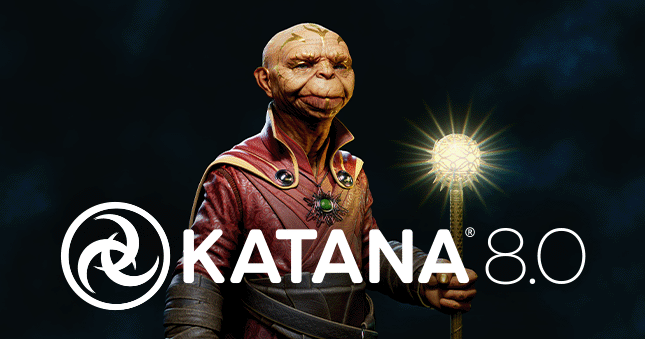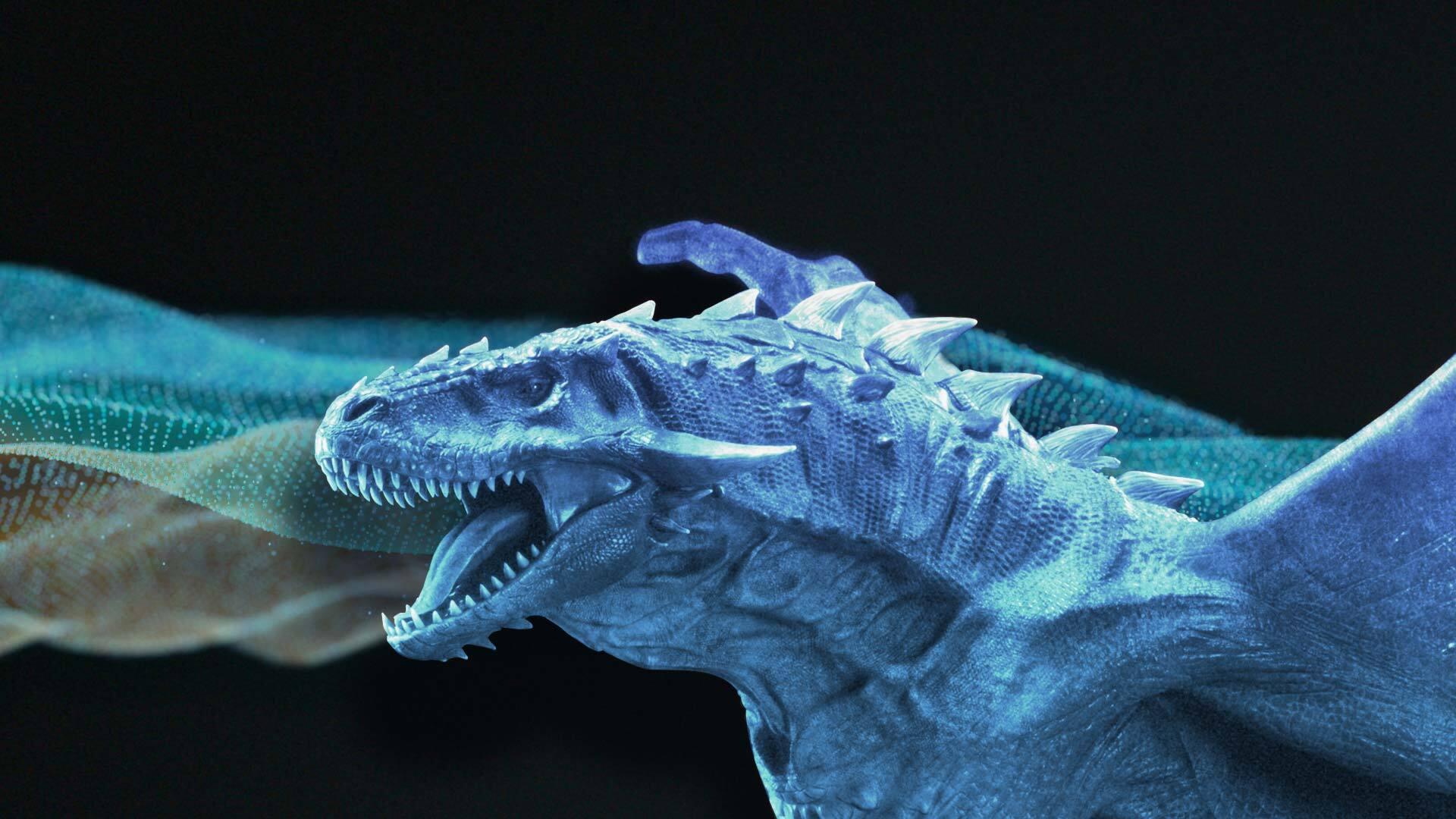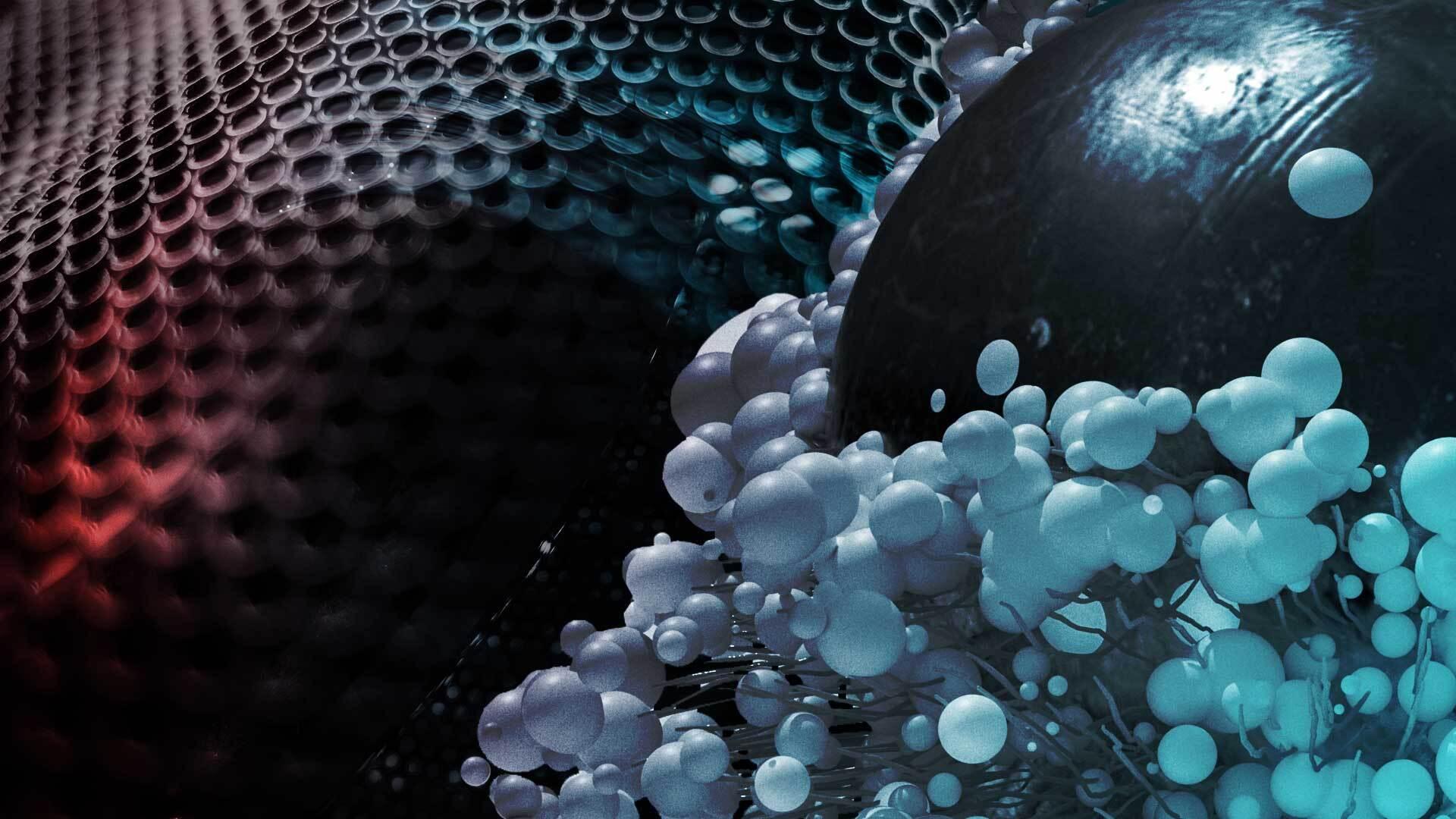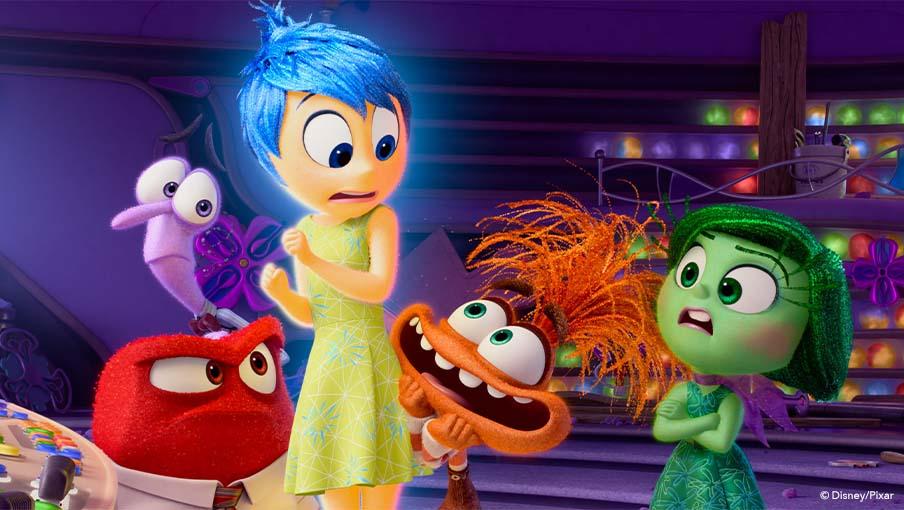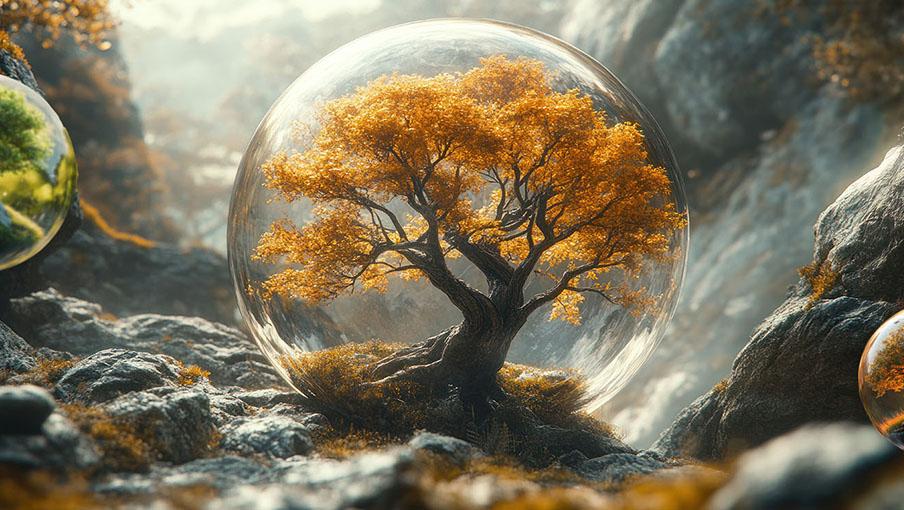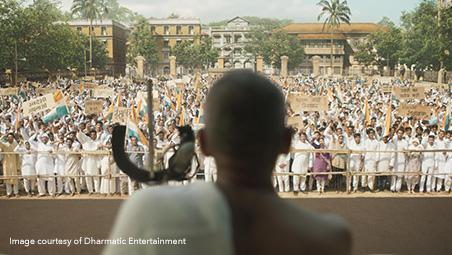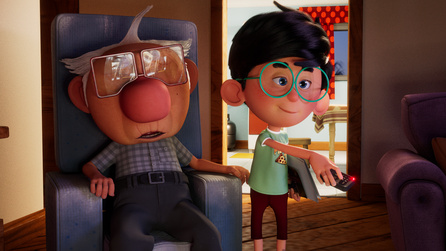ルックデベロップメント
アーティストに特化したルック開発UX
Katanaは業界最強のルック開発アーキテクチャとUXを搭載しています。アーティストは単一の複雑なアセットから数百のバリエーションに至るまで、高品質なルックを実現することができ、これはショットの制作と並行してルック開発を続行できるアーキテクチャによってサポートされています。
- 複雑なマテリアル設定の管理 - Network Material Createノードは、複数のマテリアルを作成・管理するために設計されています。このノードはノードグラフシステムの一部で、最も複雑なシェーディングネットワークであっても効率的に動作するように設計されています。
- 簡単なプロシージャル編集 - KatanaのNetwork Material Editノードは、K Katanaで作成されたネットワークマテリアルまたはUSDからインポートされたネットワークマテリアルに対して、プロシージャルな編集を行う機能を提供します。使いやすいUIを使用して、ネットワーク全体と既存の編集内容を確認できます。
- USDベースのルック開発のハブ - Katanaには、USD/Hydraのネイティブプラグインが同梱されており、USDプレビューサーフェスマテリアルの作成、利用、編集が可能です。HdStormを搭載したHydraビューアにより、その結果を高品質なビジュアルで確認することができます。
- マテリアルソロ - Katana 6.0では、作業を簡単にプレビューし、個々のノードが最終結果にどのように影響するかをよりよく理解できます。新しいマテリアルソロ機能により、アーティストはマテリアル設定のコンポーネントを瞬時に確認できるようになり、複雑なマテリアルネットワークを素早く切り分けてデバッグできます。設定の再接続を気にせず、いつでも任意のセクションをプレビューできる機能を活用して、より効率的に作業を進めることができます。
- NetworkMaterialEdit マテリアルインターフェイス - Katana 4.5で導入された機能をベースにしたNetworkMaterialEditマテリアルインターフェイス機能により、アーティストはNetworkMaterialEditノード内でマテリアルインターフェイスを簡単に変更、管理できます。ユーザーはもはやリニアな作業に制約されることなく、下流でのセットアップをより自由に変更できるようになりました。その結果 元のマテリアルが手元になくても修正が可能で、マテリアル作業時の柔軟性が向上しました。
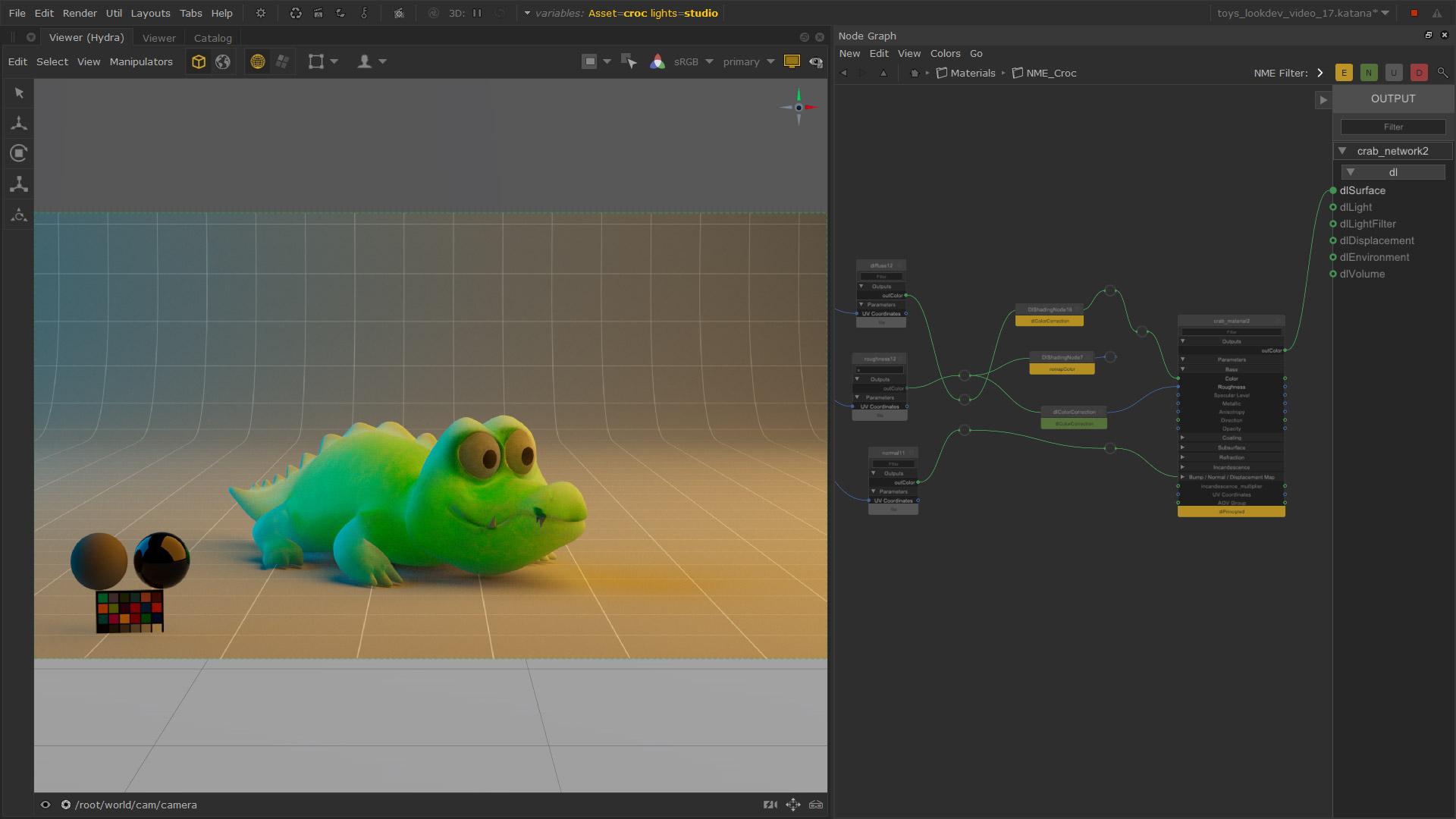
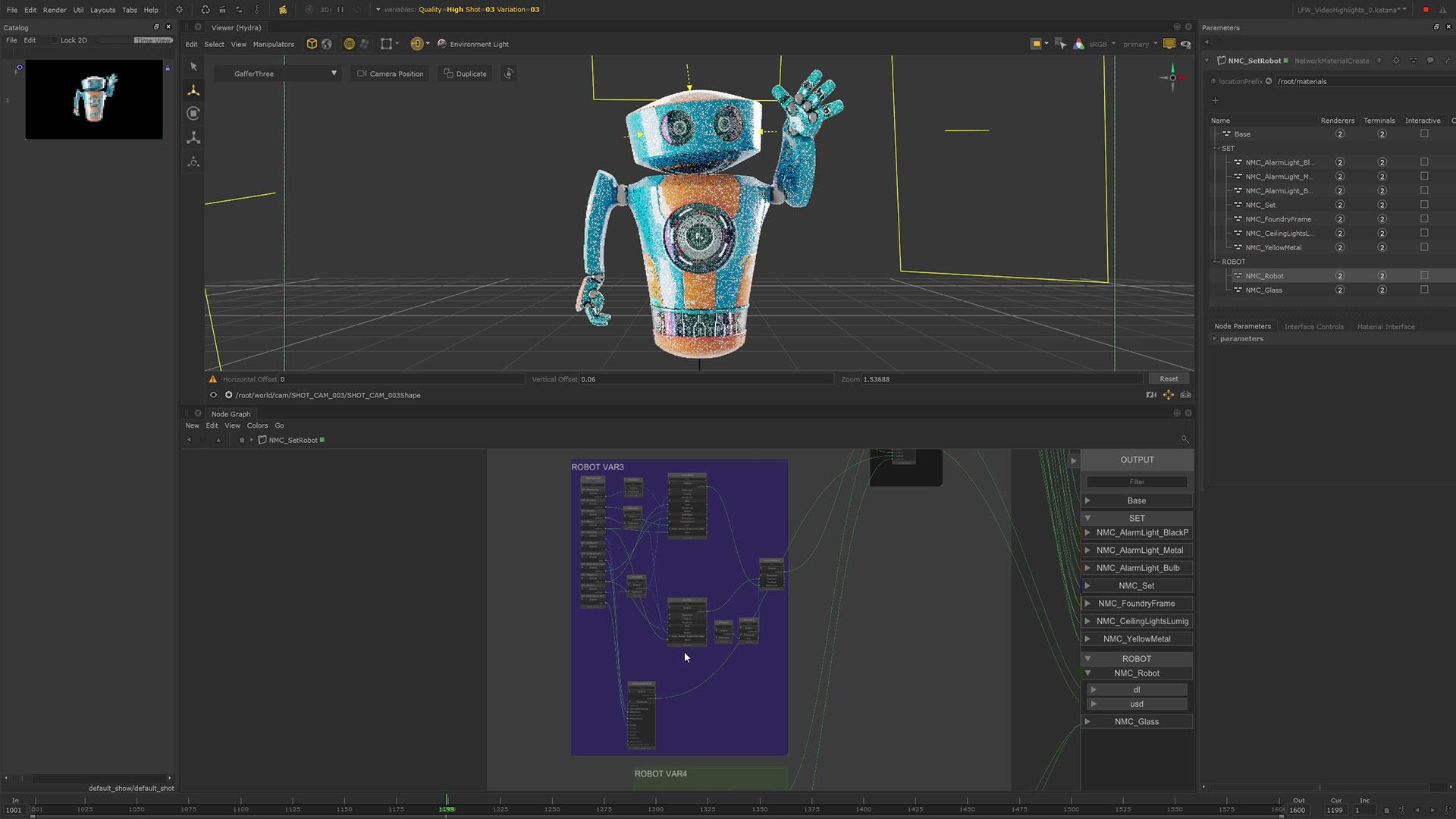
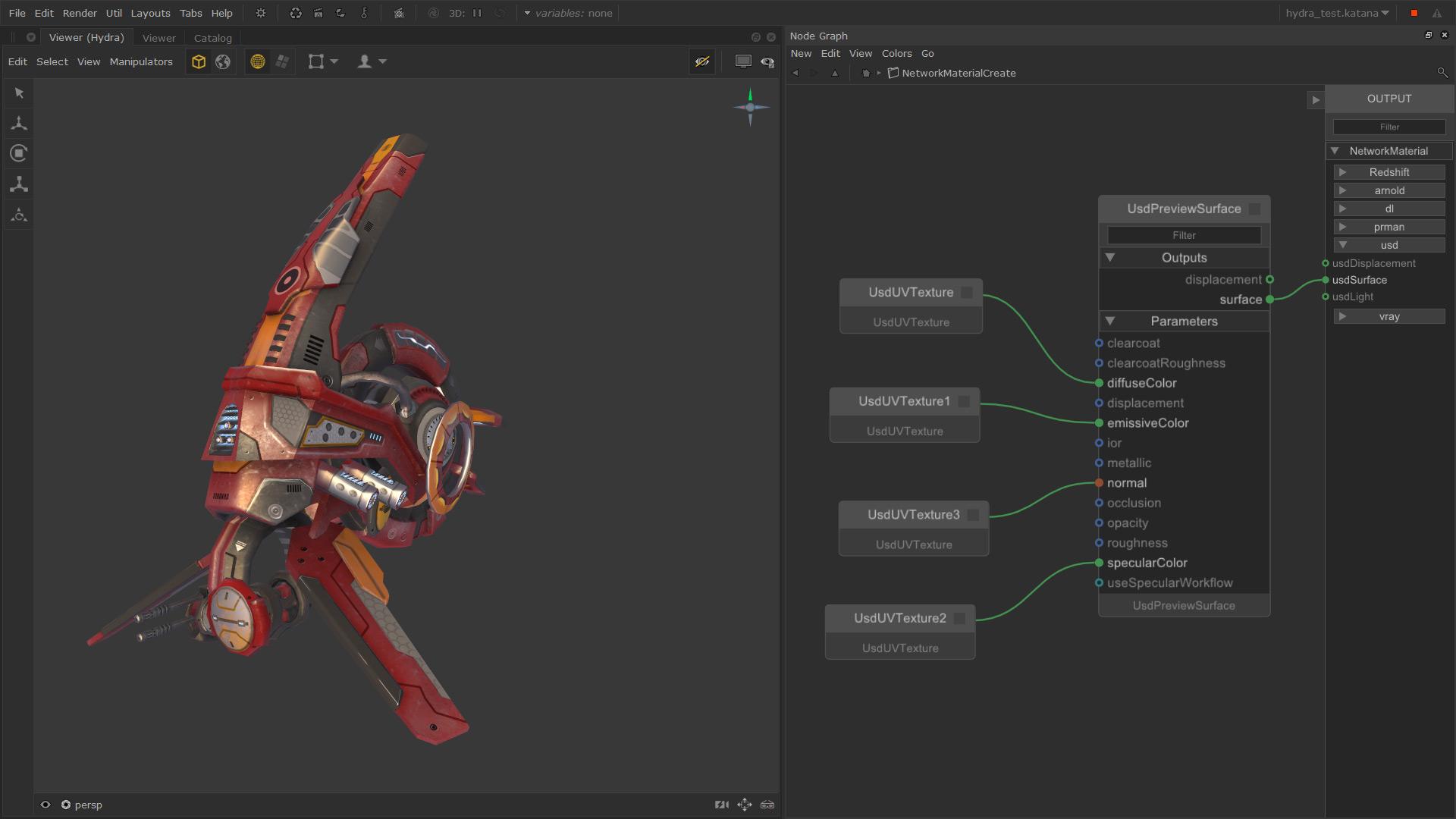
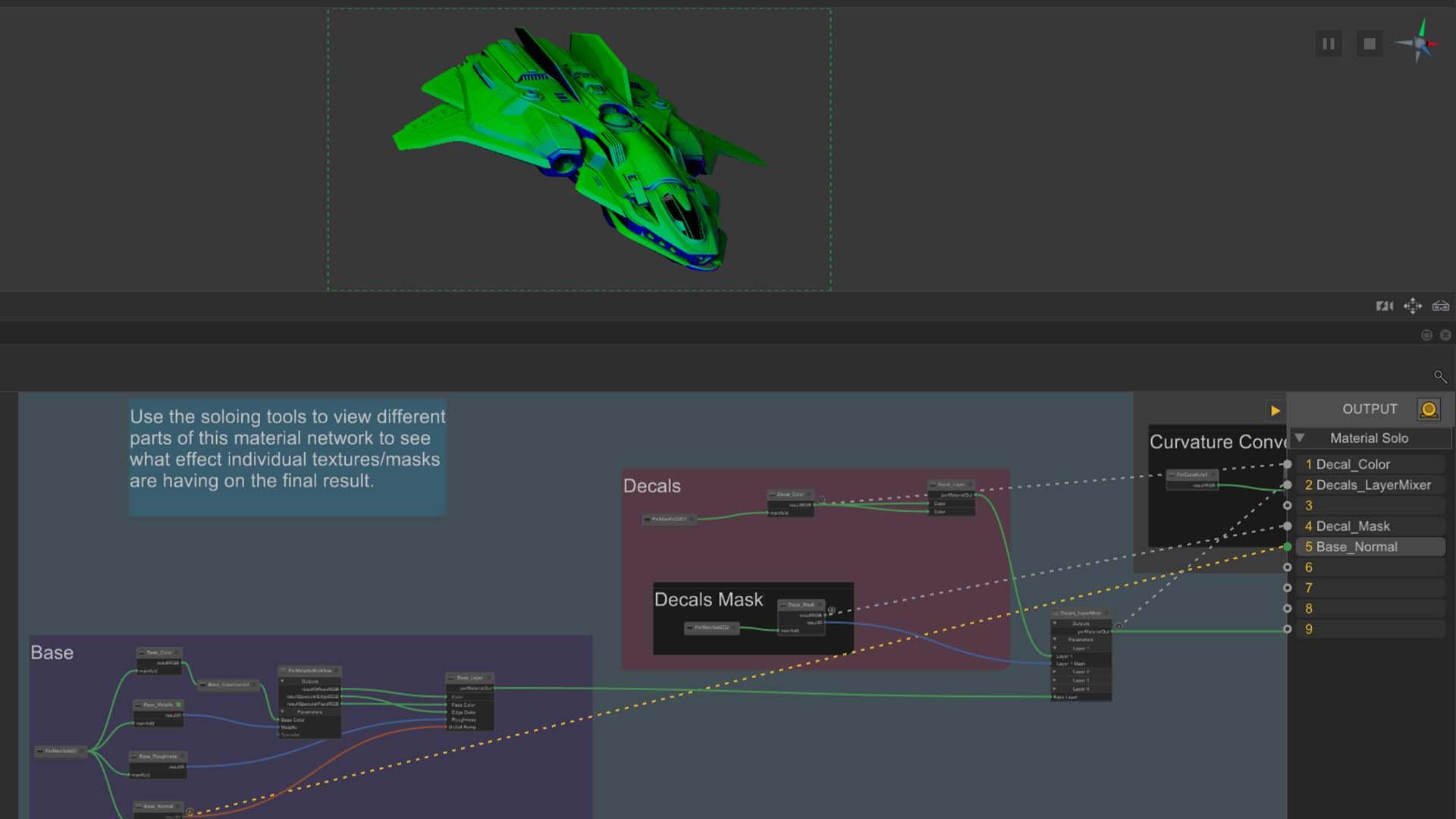
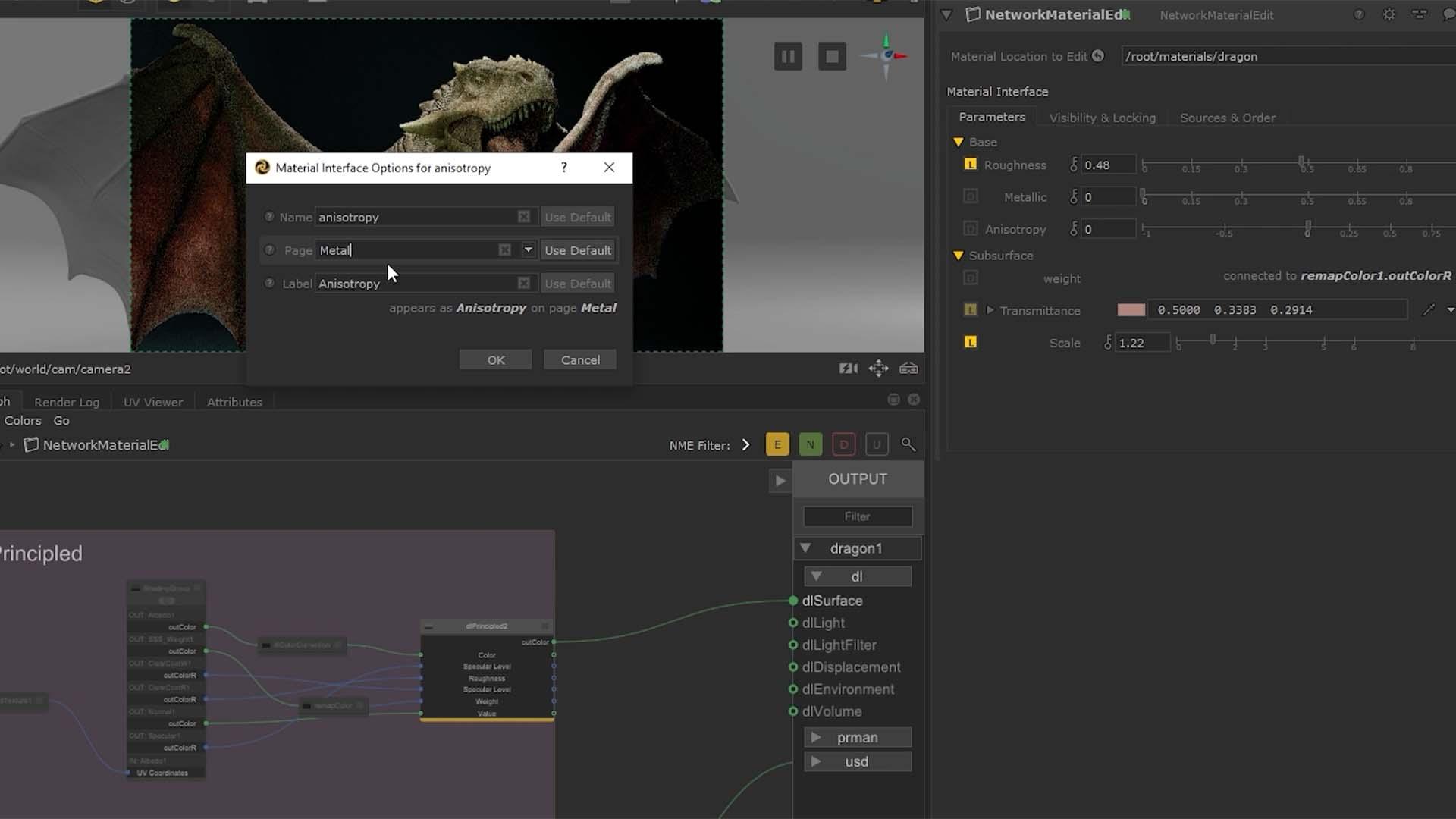
高度なルック開発ワークフロー
Katanaはルック開発を強力にサポートするさまざまなワークフローを提供し、アーティストやチーム、パイプライン全体に大きなメリットをもたらします。シニアアーティストがアートディレクションの一貫性を保つためのルック開発の基盤を作るためのツールから、個々のアーティストが期待を超える成果を上げるためのツールまで、多彩な機能が揃っています。
- ルック開発のマルチタスク - マテリアルは、複数のレンダラープラグインのサーフェス、ディスプレイスメント、またはライトシェーダーのパラメータを同時に保存できるため、ビューポートと最終レンダリングの両方のルックを一度の設定で操作することができます。
- 複雑さの管理と共有 - アーティスト向けに設計された使いやすいUIで、テクスチャーマップとレンダラープロシージャルノードを組み合わせてネットワークマテリアルを構築。複数のシェーディングネットワーク間でノードを共有し、集約されたコントロールを用いて複雑なネットワークを作成でき、アートディレクションに一貫性を持たせながら、簡単に調整や変更を行うことができます。
- 強力な階層型プロシージャルワークフロー - Katanaの親子マテリアルツールセットを使用することで、アセットのバリエーションのルック開発がこれまでになく簡単に行えます。親マテリアルの設定をもとに、子マテリアルで詳細な調整を行うことができます。
- ルック開発をモジュール化 - シェーディンググループにシェーディングネットワークを組み込むことで、複雑なシェーディング設定を簡単に共有・再利用できるようにします。シェーディンググループ内で設定された入力と出力を外部のサーフェスで直接操作でき、シェーディング作業がより効率的に行えます。
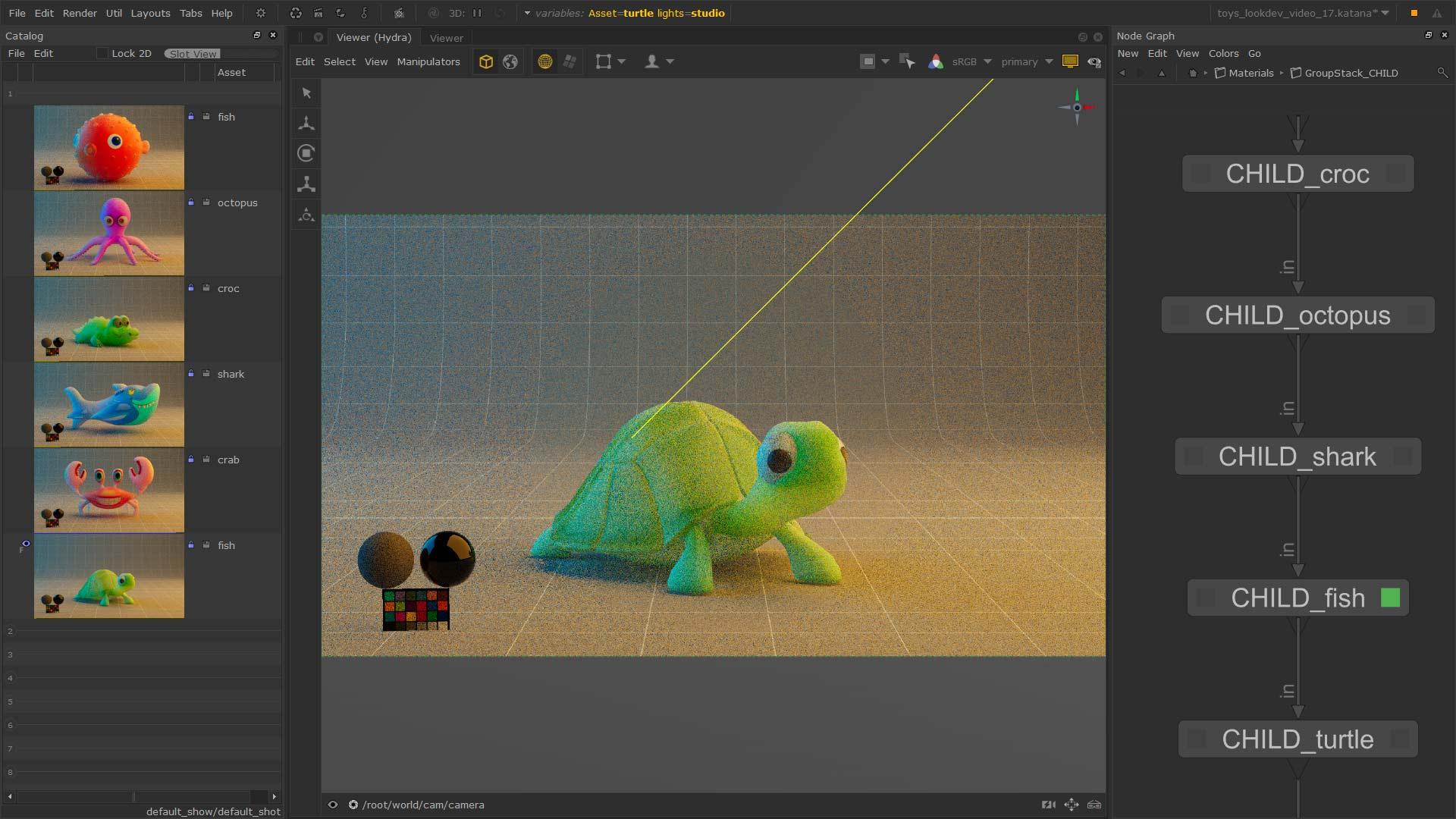
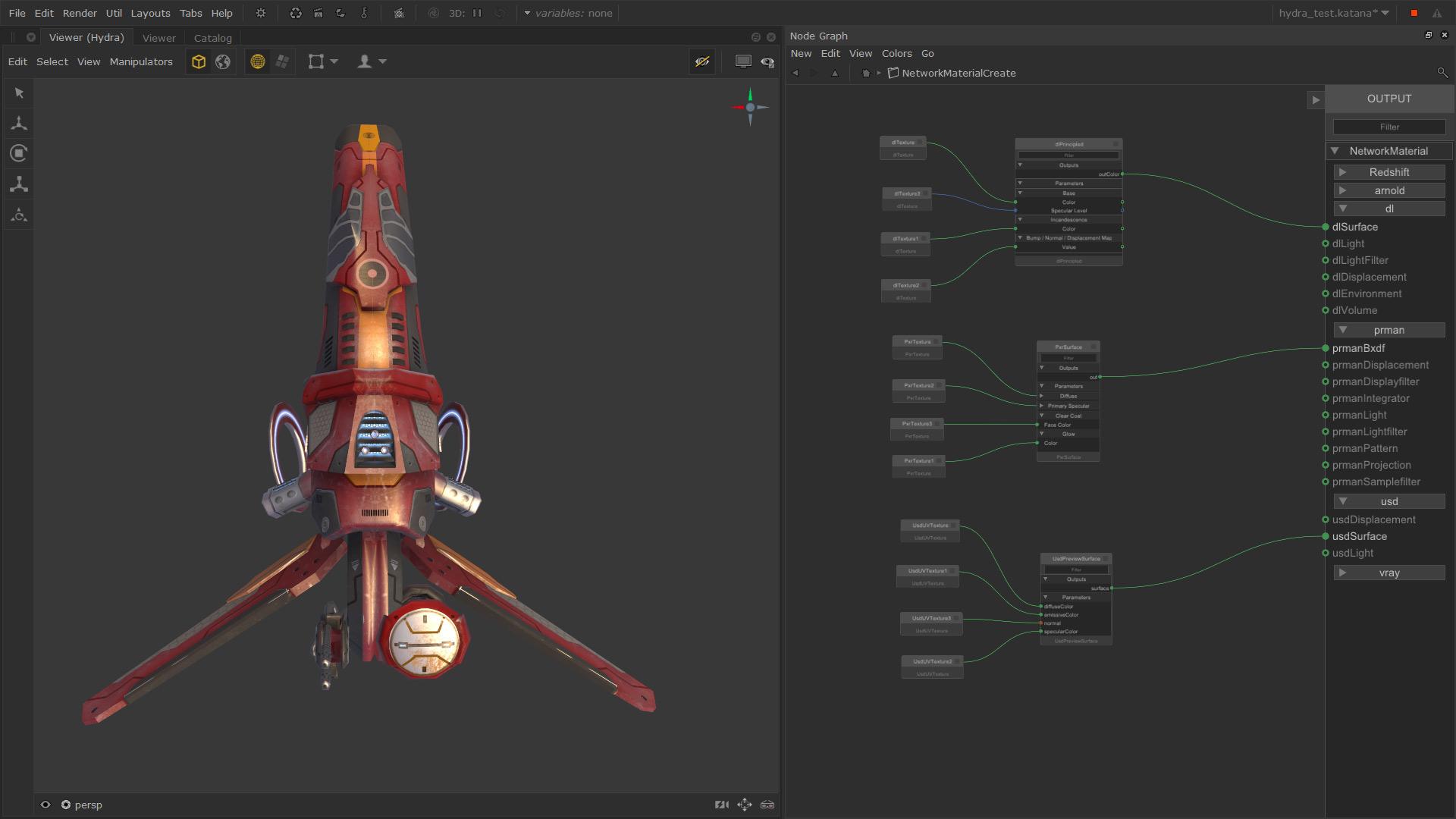
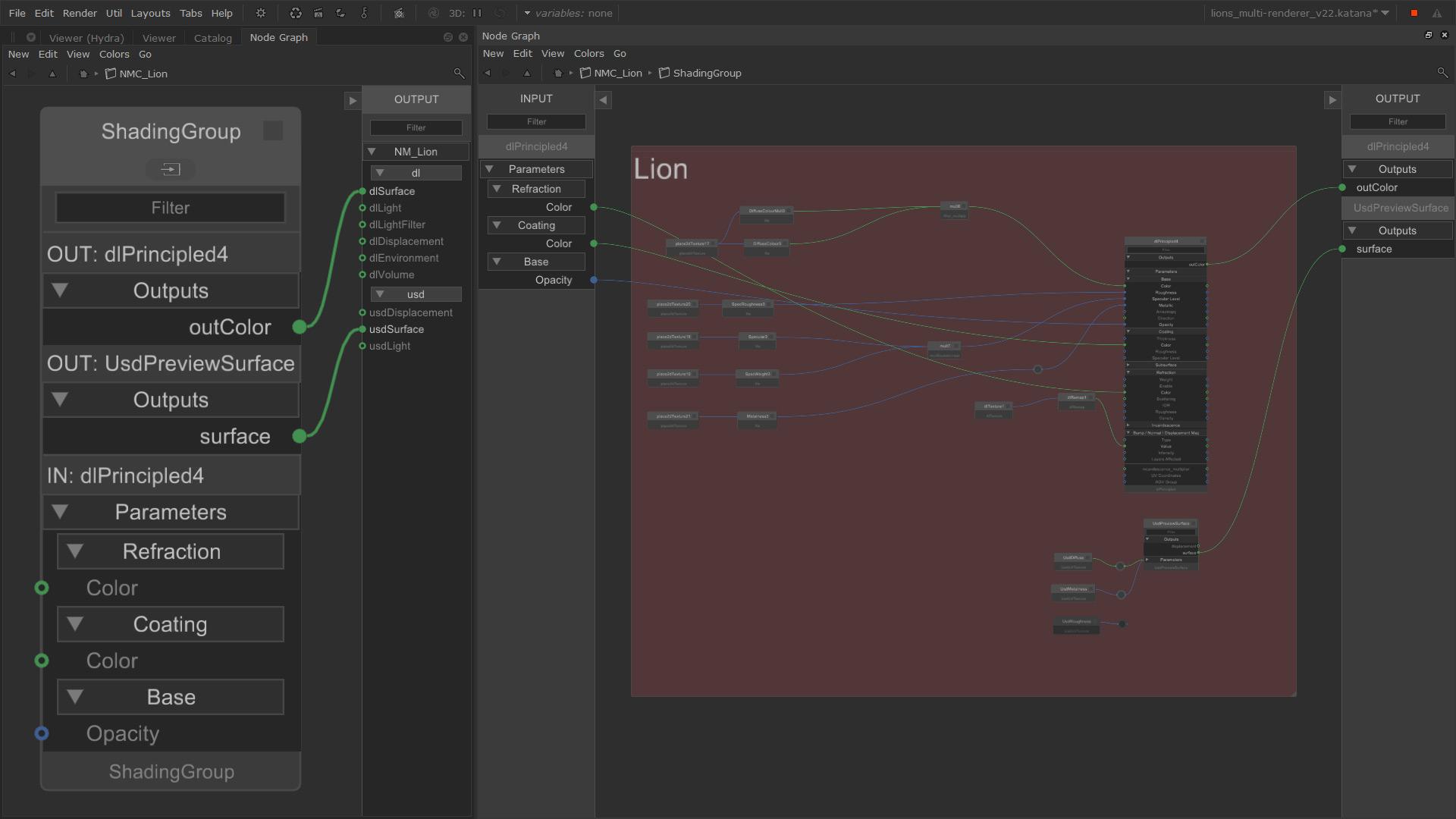
ライティング
アーティストに特化したライティングツール
Katanaのライティングツールは、UIとUXの驚くべき改善により、従来のデジタル・ライティングエクスペリエンスを刷新し、クリエイティブなワークフローを効率化します。これにより、アーティストやチームはアートディレクションの要求に直接対応できるようになり、面倒な作業に費やす時間が減り、優れた作品作りにより多くの時間を費やすことができます。
- 正確なコントロール - ライブレンダリングセッション中に、マウスやワコム製品に最適化されたジェスチャーベースのコントロールを使って、画像の上で直接作業できます。Katanaのモニターレイヤー機能を使うと、Hydraビューポートに最終的なレンダリング品質のピクセルを表示できます。詳細なUXフィードバックにより、どのライトがどのように影響を与えているのかを正確に把握でき、フルスクリーンで作業をしても、注意がそれることなく集中して作業を続けることができるというメリットもあります。
- インタラクティブにライティング - イメージやシーン内のオブジェクトと直接インタラクションを行いながら、ライトを作成、編集できます。映画の撮影監督が実際の物理的なセットでライトを動かすように、直感的に素早くライティング作業が行えます。
- 直感的なライティング操作 - Katanaのビューアでは、シンプルなヘッドアップディスプレイで直接作業し、強度、露出、色などの光のプロパティをコントロールできます。これにより、ライティングシナリオ(光の設定)を直接ビューア上で管理しやすく、より自由に操作することができます。
- 直感的に操作できるGafferコントロール - 名前の変更、削除、編集のためのライトの選択など、一般的なタスクをビューアで直接実行できます。これらのコントロールは、ビューアから直接コントロールできるアクティブノードグラフ内にあるすべてのGaffer Threeノードに対して利用できます。
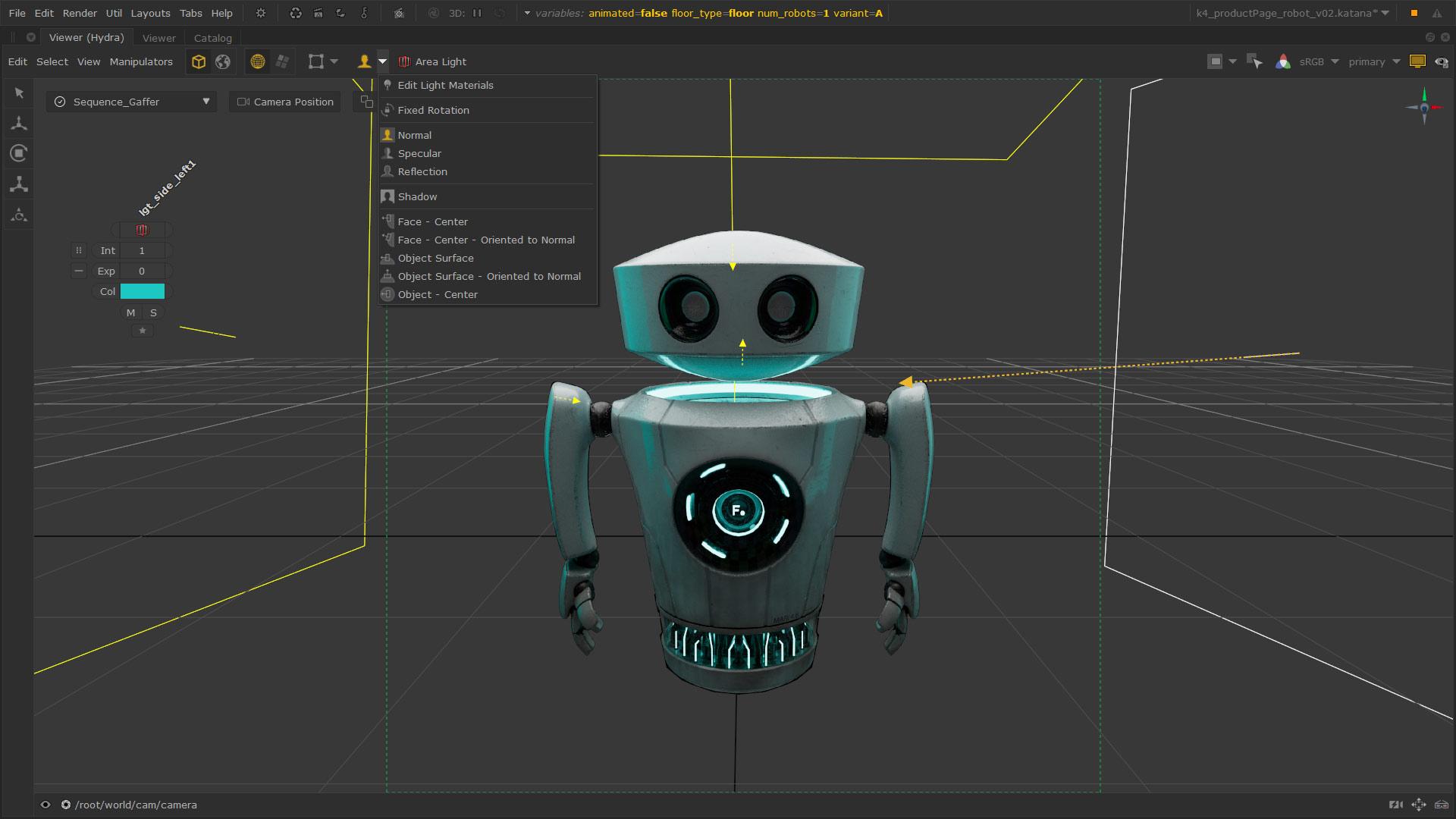
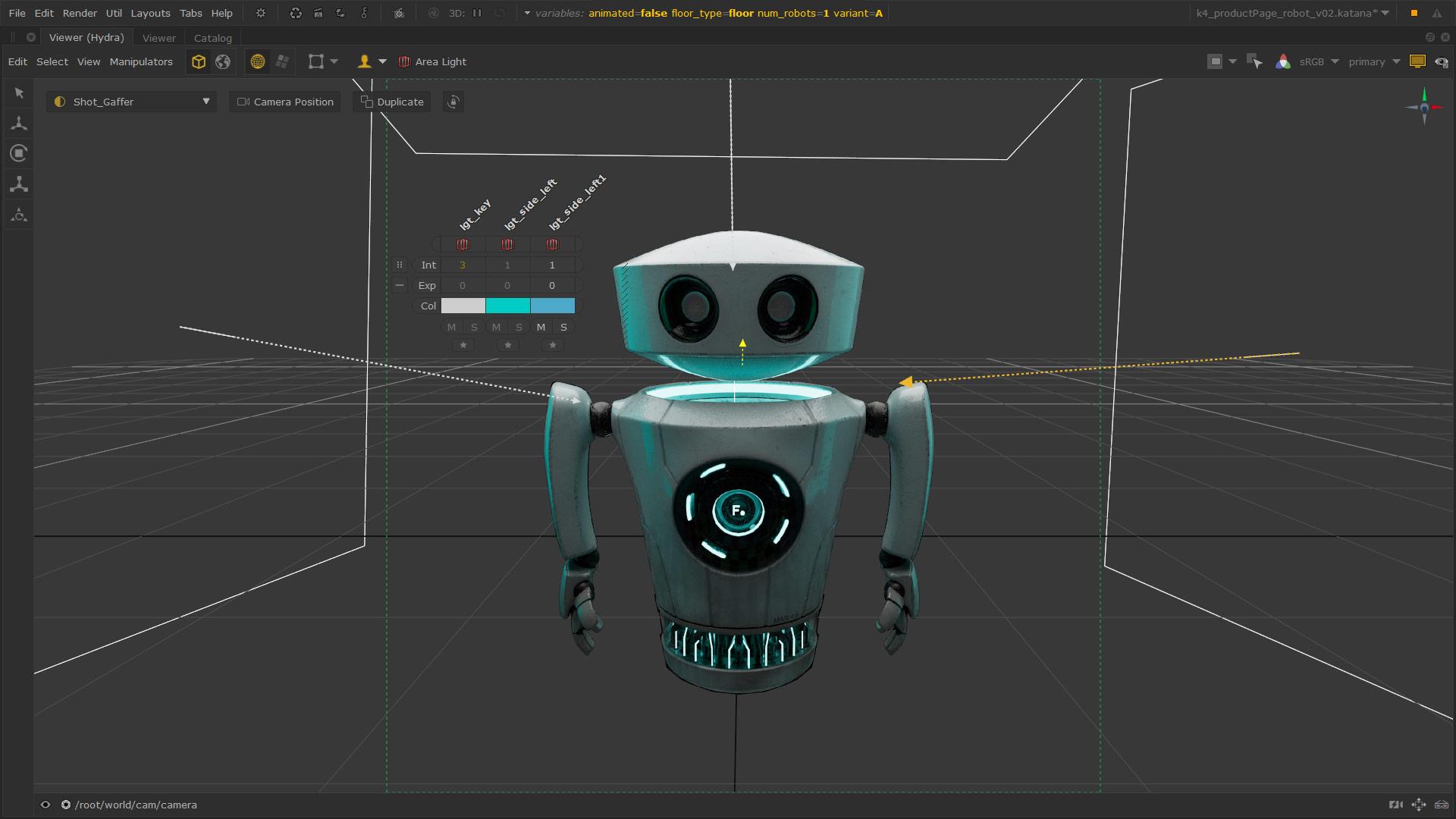
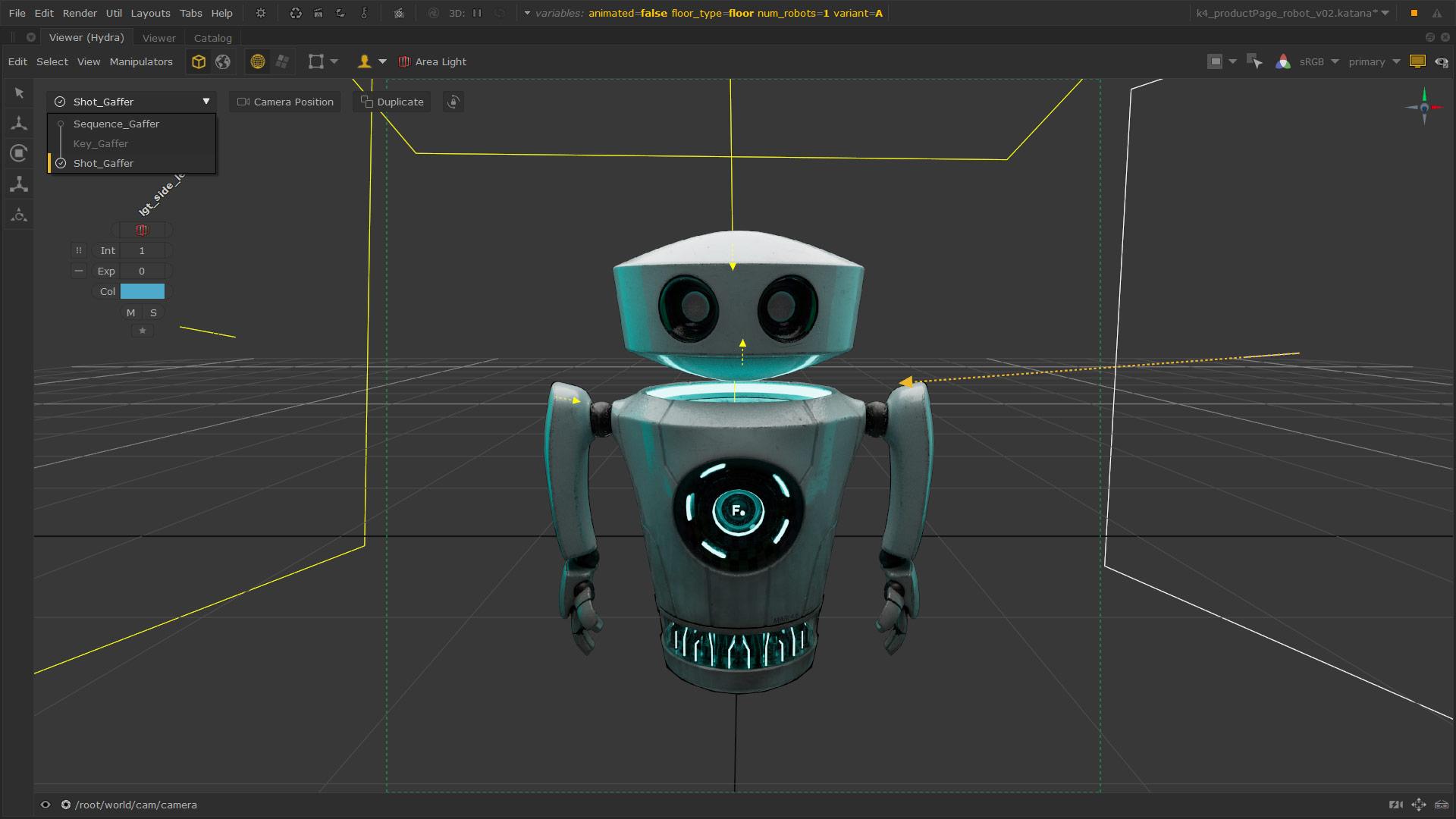
ライティング制作に特化したツールセット
Katanaのライティング制作ツールセットは、単一のショットでもシークエンス全体でも、作業時間を短縮できるように設計されており、最小限のアーティストで最大量の高品質なショット制作を管理できます。ディファードローディング、プロシージャルワークフロー、コラボレーションツール、多機能なビューア、ライブレンダリングフィードバックなど、すべての機能がアーティストやチームを強力にサポートします。
- プロシージャルなシークエンスベースのライティング - KatanaのGafferThreeノードは、ライトの作成と編集を1つのノードにまとめ、個々のライトを直接操作したり、テンプレートマテリアルを介して複数のライトを同時に制御したりすることができます。また、既に作成されたライトに対して、精密なプロシージャルな編集を行うことができます。
- 世界水準のインタラクティブレンダリング - Katanaは、すべてのレンダリング編集を個々の変更としてレンダリングプラグインに伝達します。これにより、レンダリングプラグインベンダーは変更の詳細な情報を取得することができます。堅牢なレンダリングAPIにより、レンダリングプロセスの不具合によるクラッシュが発生することはなくなり、問題を特定してレンダリングを再開することができます。
- 豊富なアーティストフィードバック - Katanaの高度にカスタマイズ可能なUIにより、KatanaのHydraビューポートでリアルタイムでライトやシャドウを操作・確認でき、レンダリング結果もモニターレイヤーやモニタータブで視覚的に確認しながら作業が行えます。一方、カタログシステムは、現在および過去のレンダリングの全履歴にわたるライティングフィードバックを提供します。
- シーンデータのベイク処理が不要に - Katanaはレンダリングプロセス中にレンダラーと直接通信し、シーンデータを必要に応じて供給します。これにより、ベンダー固有のアーカイブファイル形式にデータをベイクする必要がなくなり、プロセス全体を通して完全なコントロールが可能になります。
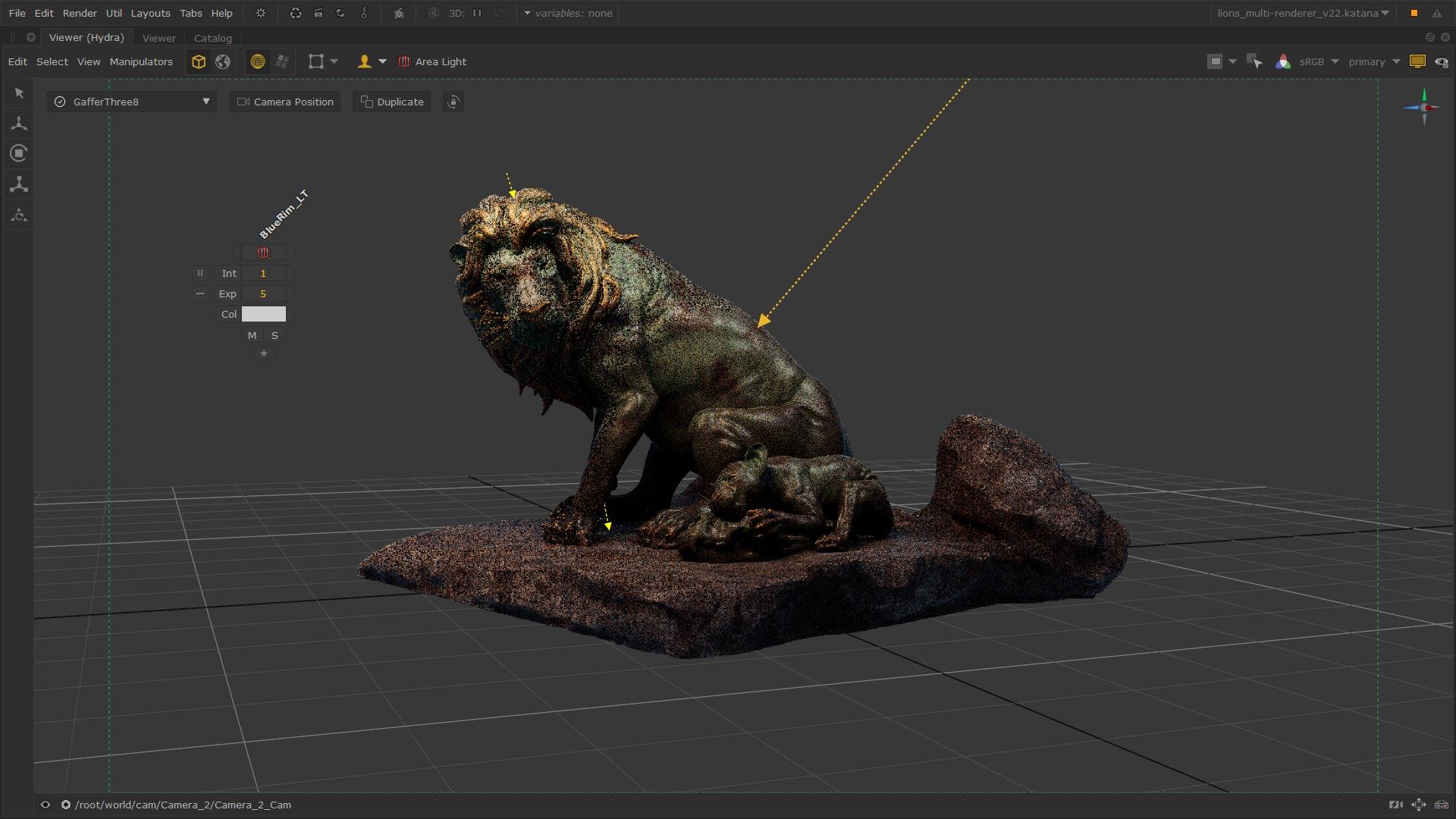

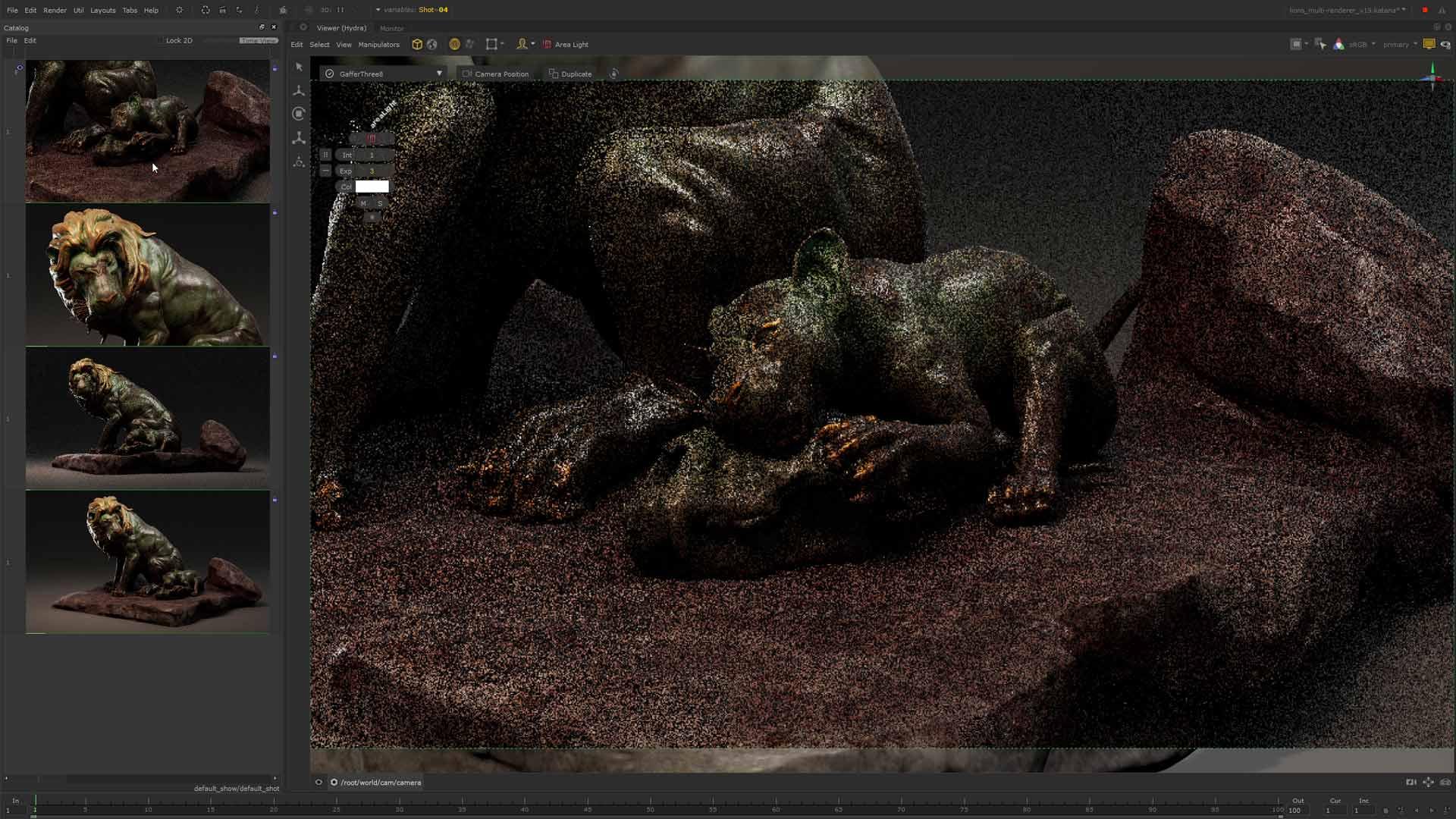
アーティスト
USDライト作成
アーティストはKatanaのUSDステージ上で直接ライトを作成できるようになり、シーンをGeolibに変換する手間が省けました。これにより、USDパイプラインの完全導入を目指すスタジオでも、作業がよりスムーズに進むようになります。

HydraビューアにおけるUSDの改善
USDプライム(ライトやカメラ用の新しいロケーターを含む)がHydraビューアで操作できるようになり、USDネイティブで作業するアーティストの作業環境がさらに改善されました。
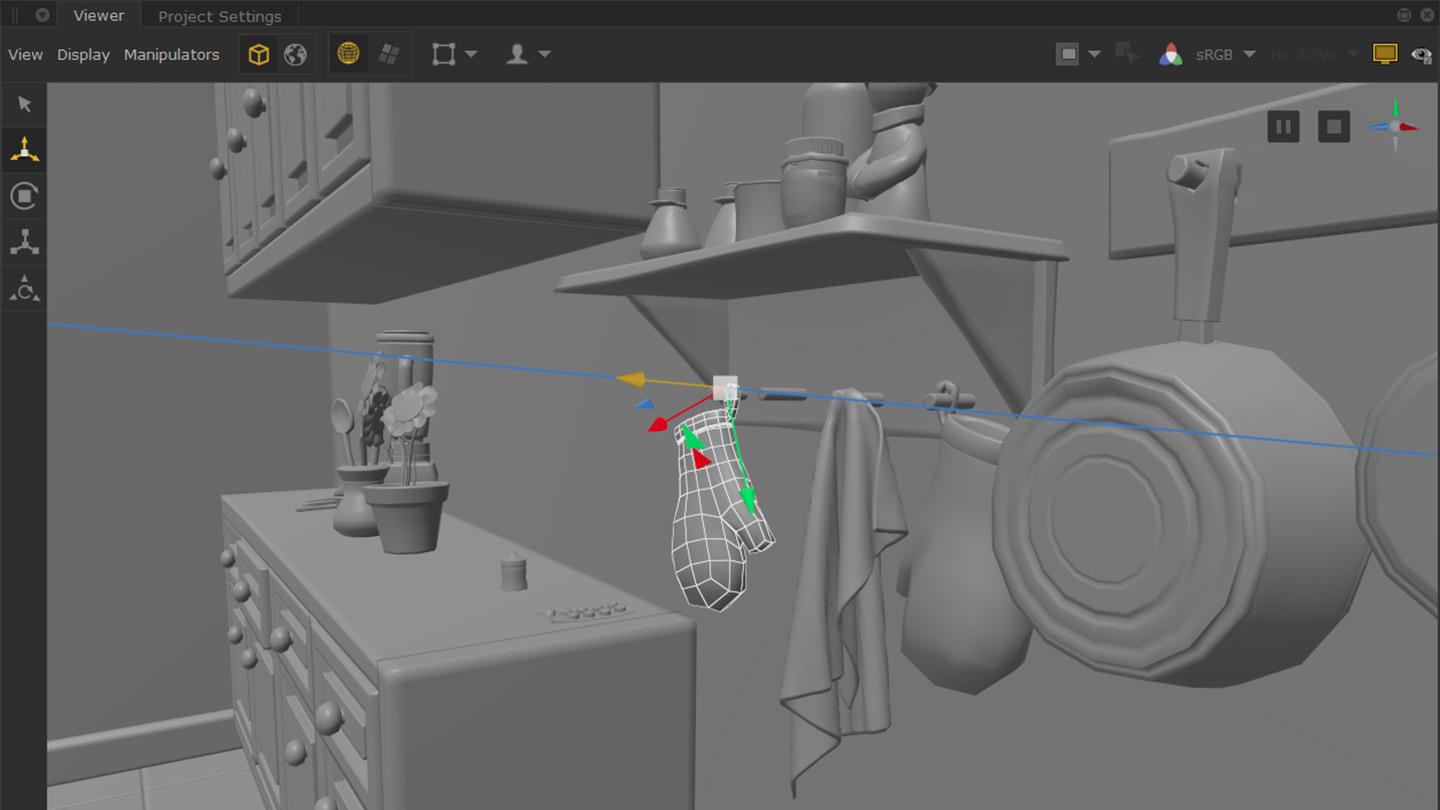
パフォーマンス向上:トラバーサル最適化
アーティストにとって、特にノード内のパラメータを変更する際の操作性が向上し、よりスムーズな作業が実現しました。また、ノードグラフの処理がPythonからC++に移行されたことにより、シーンの読み込み速度はKatana 7.0と比べて最大2.5倍速くなりました。
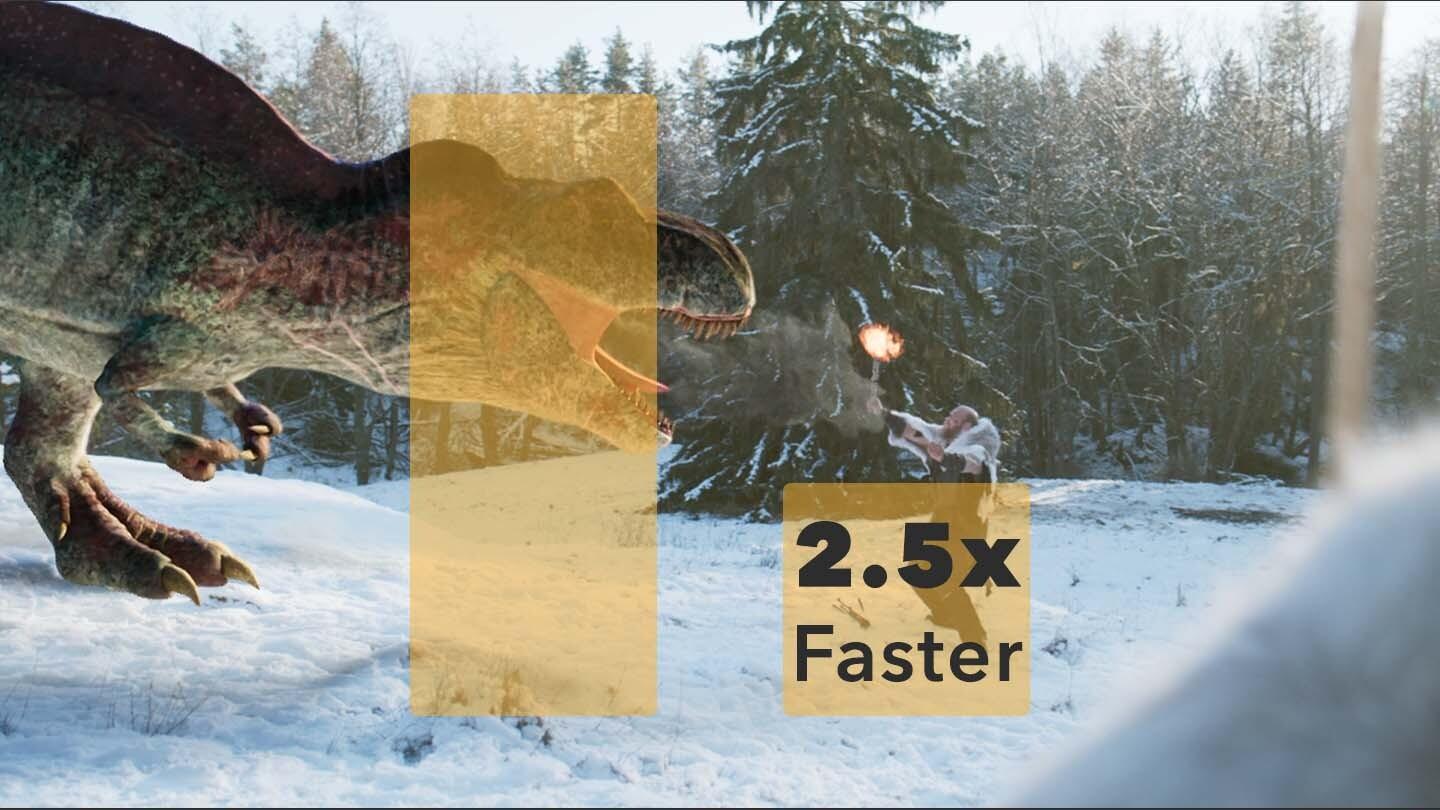
マルチスレッド対応のライブレンダリング
アップグレードされたマルチスレッド対応のライブレンダリングにより、インタラクティブな更新速度が最大2倍高速化されました。強化されたライブレンダリングとForesight+との互換性により、生産性とパフォーマンスを大幅に向上させ、妥協することなく作業が進められます。
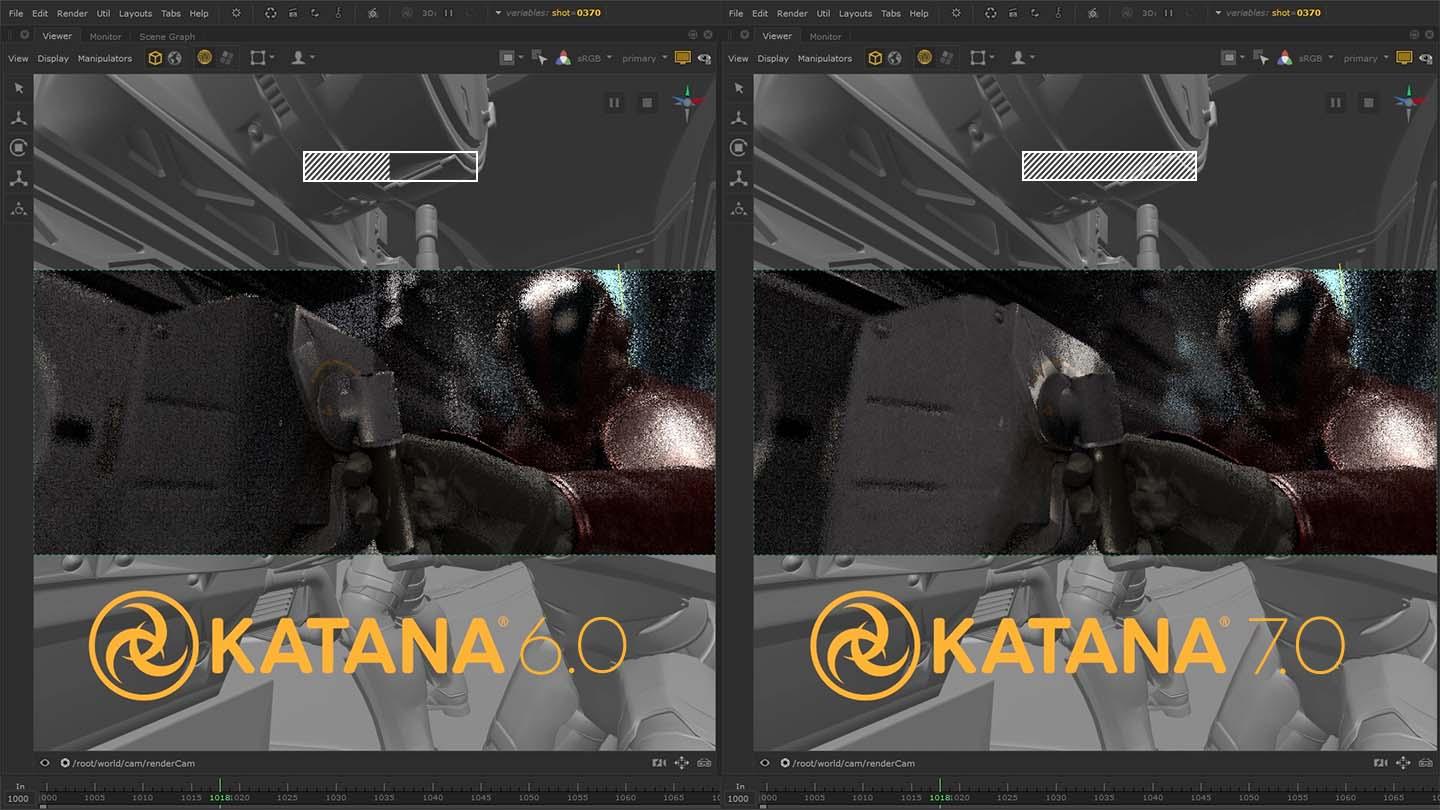
先進的なForesightレンダリング
Katanaのスケーラブルなインタラクティブレンダリング機能は、あらゆるパイプラインで非常に強力なクリエイティブワークフローを実現します。1つのKatanaプロジェクトファイル内で、複数のショット、フレーム、またはアセットにわたって作業しながら、複数の画像を同時にレンダリングできます。複数のマシンをネットワーク化して共同で処理を行うことで、レンダリング速度が向上し、スケーラブルなフィードバックが得られ、レンダリング結果を確認しながら確実に作業を進めることができます。
- Multiple Simultaneous Interactive Rendering - マルチタスクが簡単に: 新しく構築されたAPIにより、Katanaは複数のレンダリングを同時に実行できるようになりました。同じファイル内で複数のショット、アセット、タスクに対して作業を進めながら、画像をレンダリングすることができます。
- ネットワーク化されたインタラクティブレンダリング - レンダリングには計算処理能力が必要です。そのため、ネットワーク化されたインタラクティブレンダリングでは、アーティストが作業しているマシン以外のネットワーク化されたマシンを使って、1つのKatanaセッションで複数のインタラクティブレンダリングを同時に行うことができます。
- カスタマイズ可能なレンダーキューシステム - 小規模なレンダーキューシステムであるKatana Queueは、マルチタスク時にマシンの性能を最大限に活用できるように設計されています。これは、Katana Queueタブと呼ばれる新しいプロセスコントロールインターフェースを使用して、レンダリングのプロセスを完全にコントロールすることができます。
- 複数の同時レンダリングを活用するための柔軟なUX - KatanaのCatalogおよびMonitorタブは、複数のレンダリング結果を効率的に表示・操作するための便利な機能を提供します。ユーザーが設定可能なサムネイルで複数のレンダリングをリアルタイムで更新して表示したり、2つの画像を詳細に同時に操作することができます。また、1つのレンダリングを異なる視点やズームレベルで同時に確認することもできます。
- Mass Render Submission - Katanaには、複数のレンダリングタスクを提出するためのサンプルツールが用意されています。これは、シンプルなUIを作成するサンプルスクリプトの形で提供され、レンダーノード、フレーム、Graph State Variablesの可能な組み合わせを表示します。
- Foresight+: 無制限のライブレンダリング- KatanaのForesight機能をベースにしたForesight+は、関連するライブレンダーにのみ選択的な変更を適用できるようにする追加のアーキテクチャ更新を行い、一方で1つのテンプレートから複数のショットを同時に作業できるようにします。その結果、シーケンス内のすべてのショットに影響を与える変更を、翌日のレビューを待たずにKatana内でリアルタイムに確認できます。これにより、予期しない問題や変更がない状態で、ショットの品質を一貫して保つことができます。
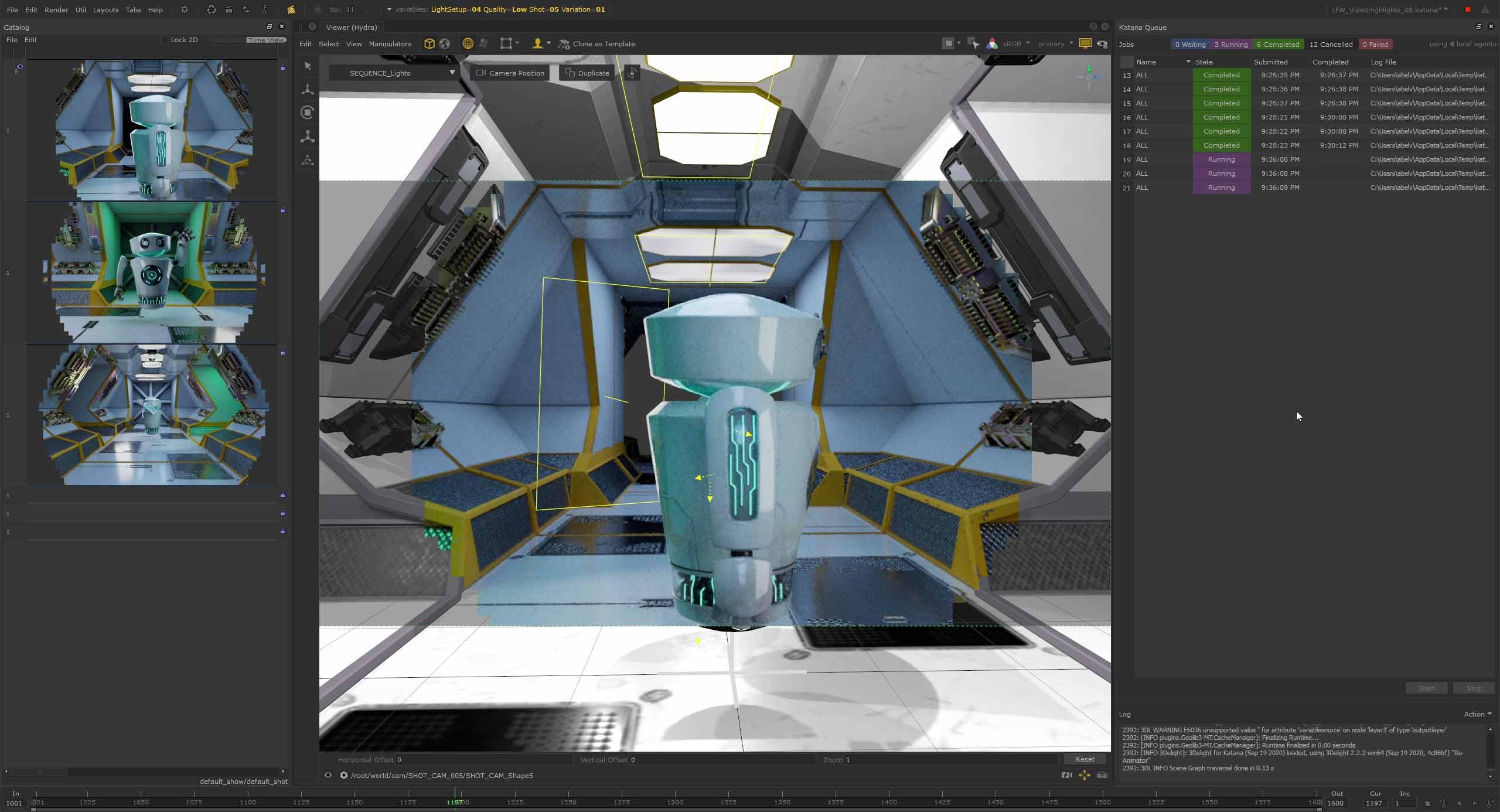
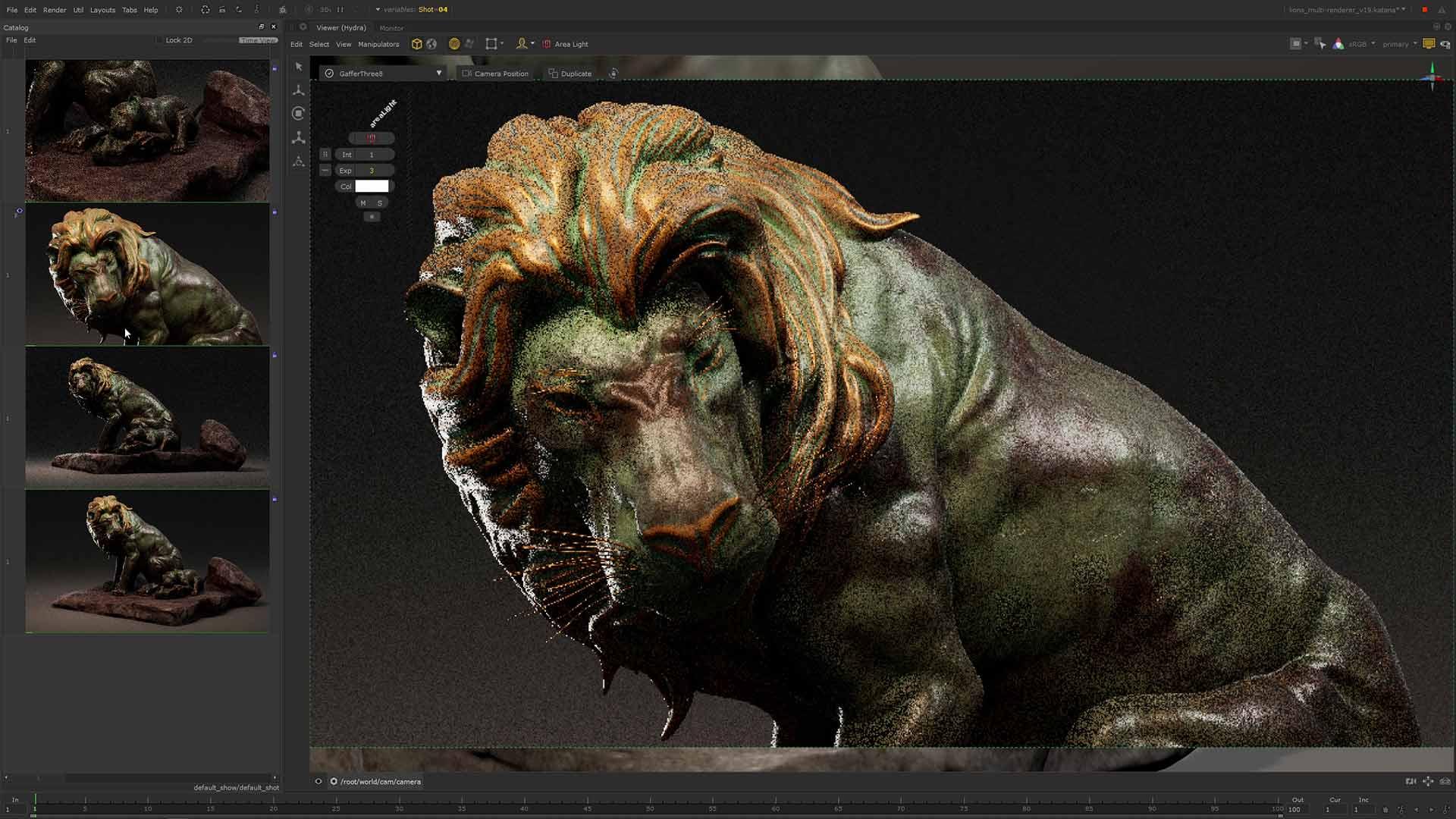
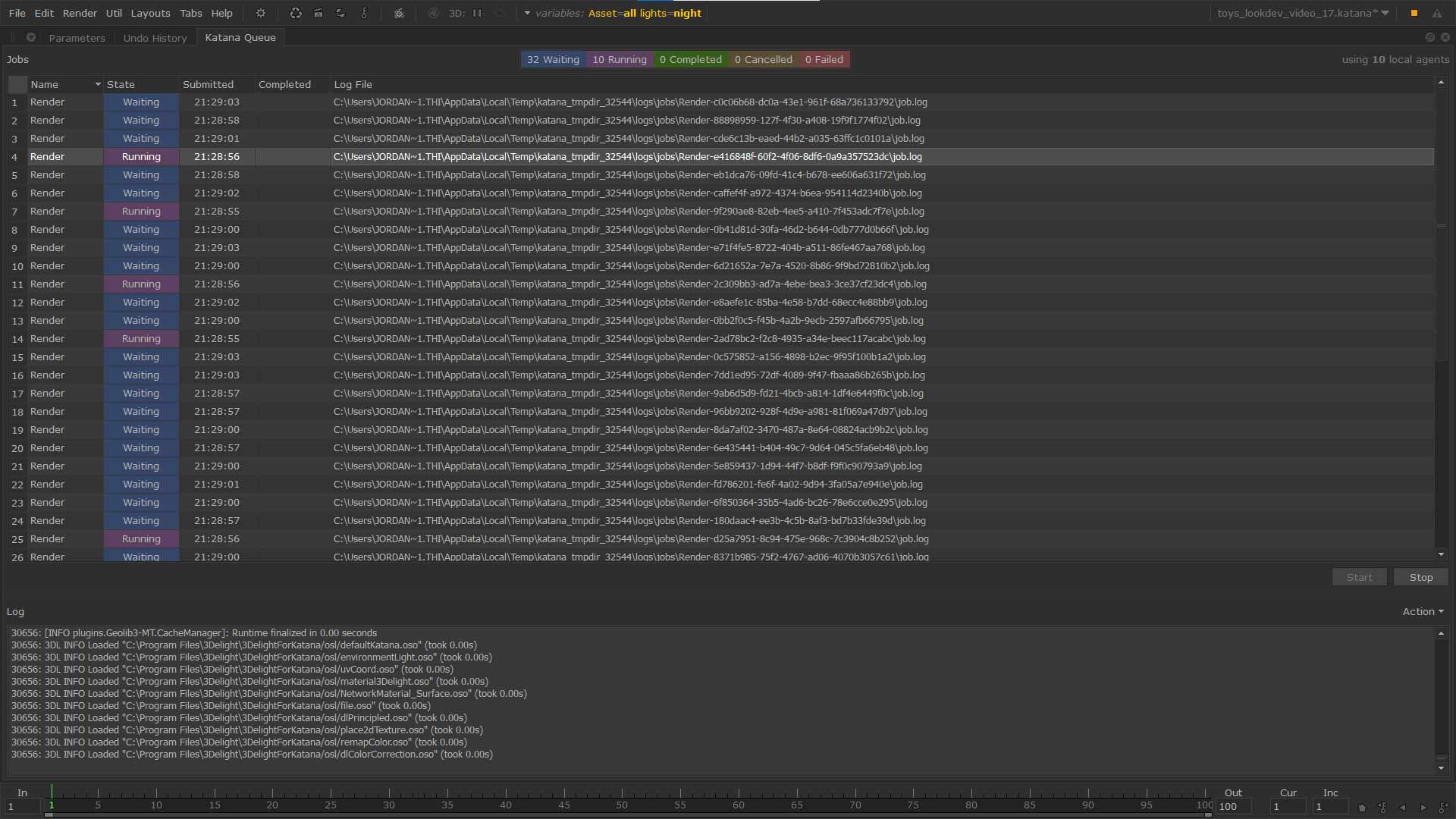

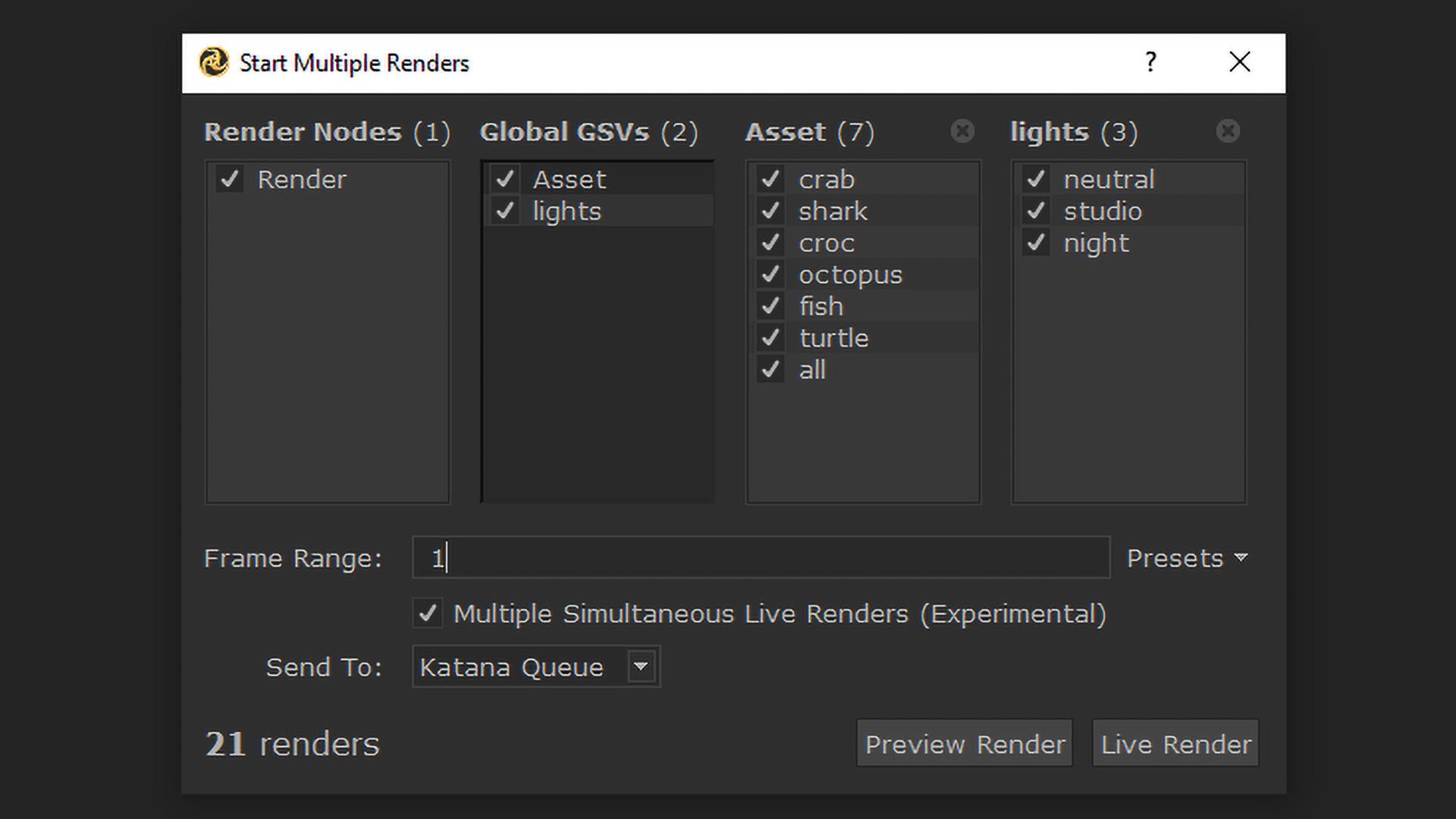
超強力なビューア
Katanaは、PIXARのUSD Hydraテクノロジーを採用した最新かつ強力なビューアが搭載されています。これは、最新のグラフィックスカードとスムーズに連携できるように設計されており、大規模なシーンやデータを効率的に処理することができます。
- 豊富なPBR GLフィードバック - KatanaのHydraビューワーは、KatanaとHydra、そしてHd Stormレンダーデリゲートに接続するブリッジの書き換えにより、優れた表示精度とパフォーマンスを実現し、USDデータの処理能力を強化、より豊かなビューア体験を提供します。
- Monitor Layer - Katanaのデジタルシネマトグラフィワークフローの重要な要素であるMonitor Layerは、レンダラープラグインの出力を直接ビューアで表示でき、レンダリングされた画像上で、選択ツールを使ってオブジェクトを直接選ぶことができます。
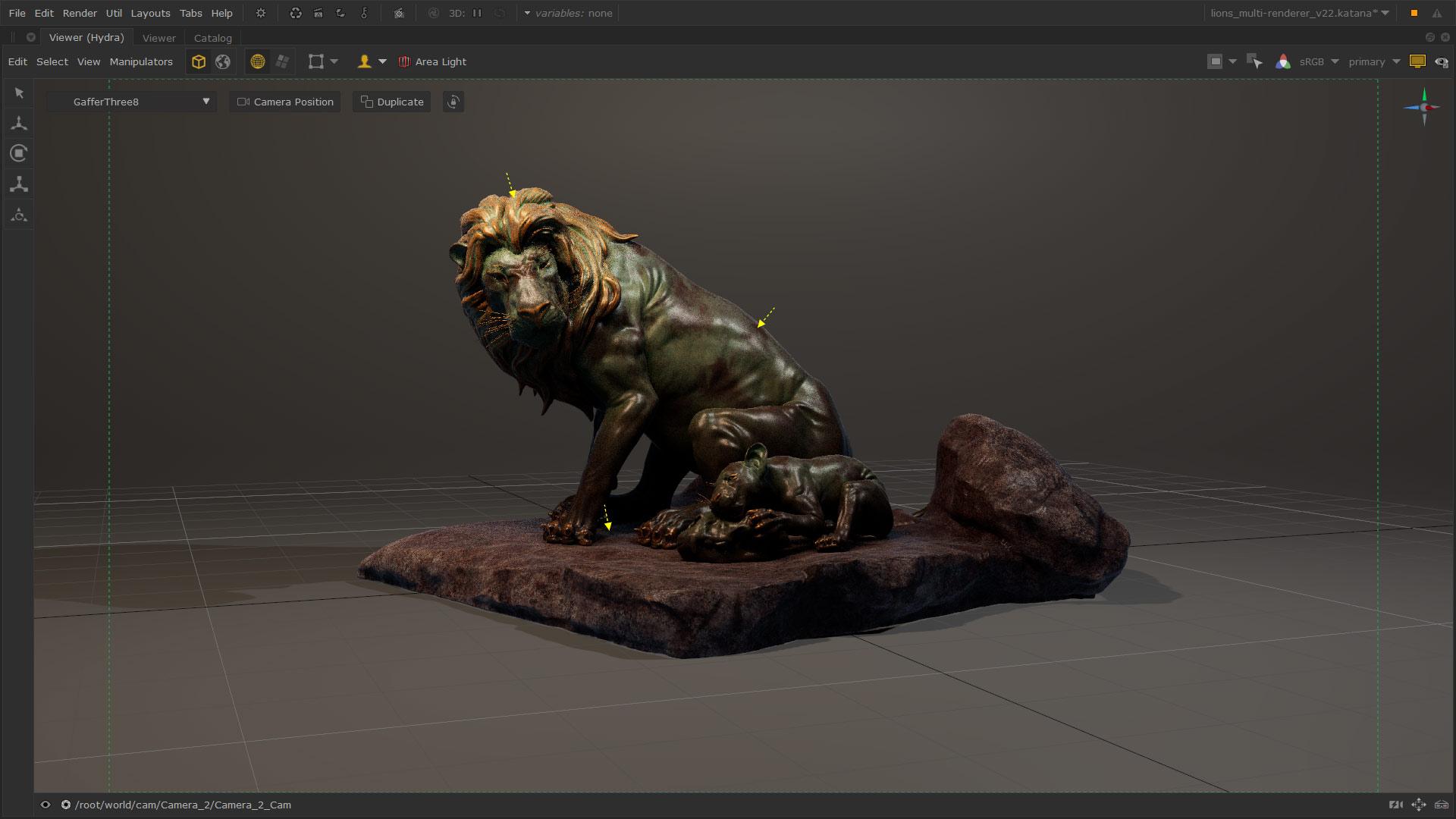
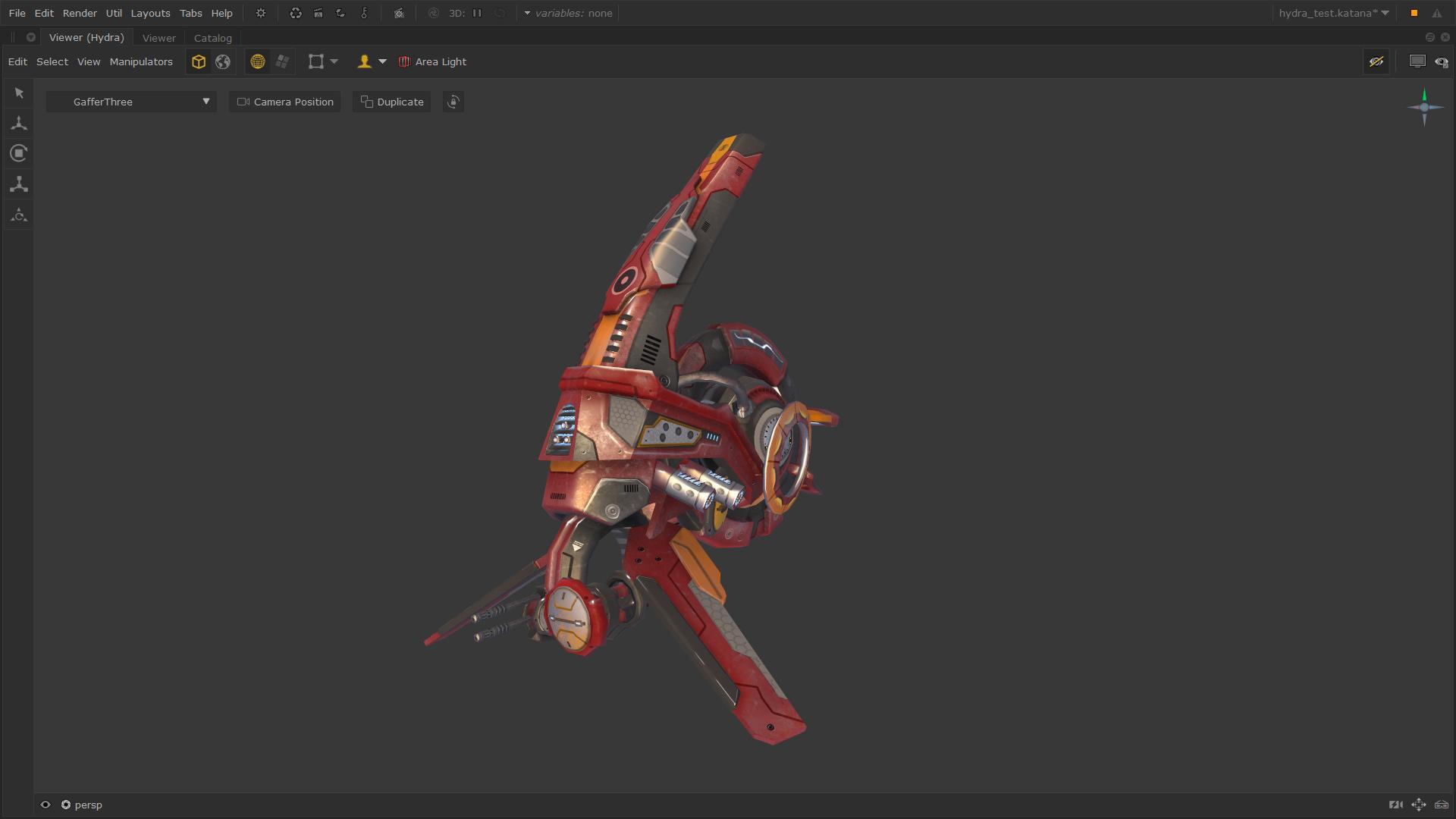
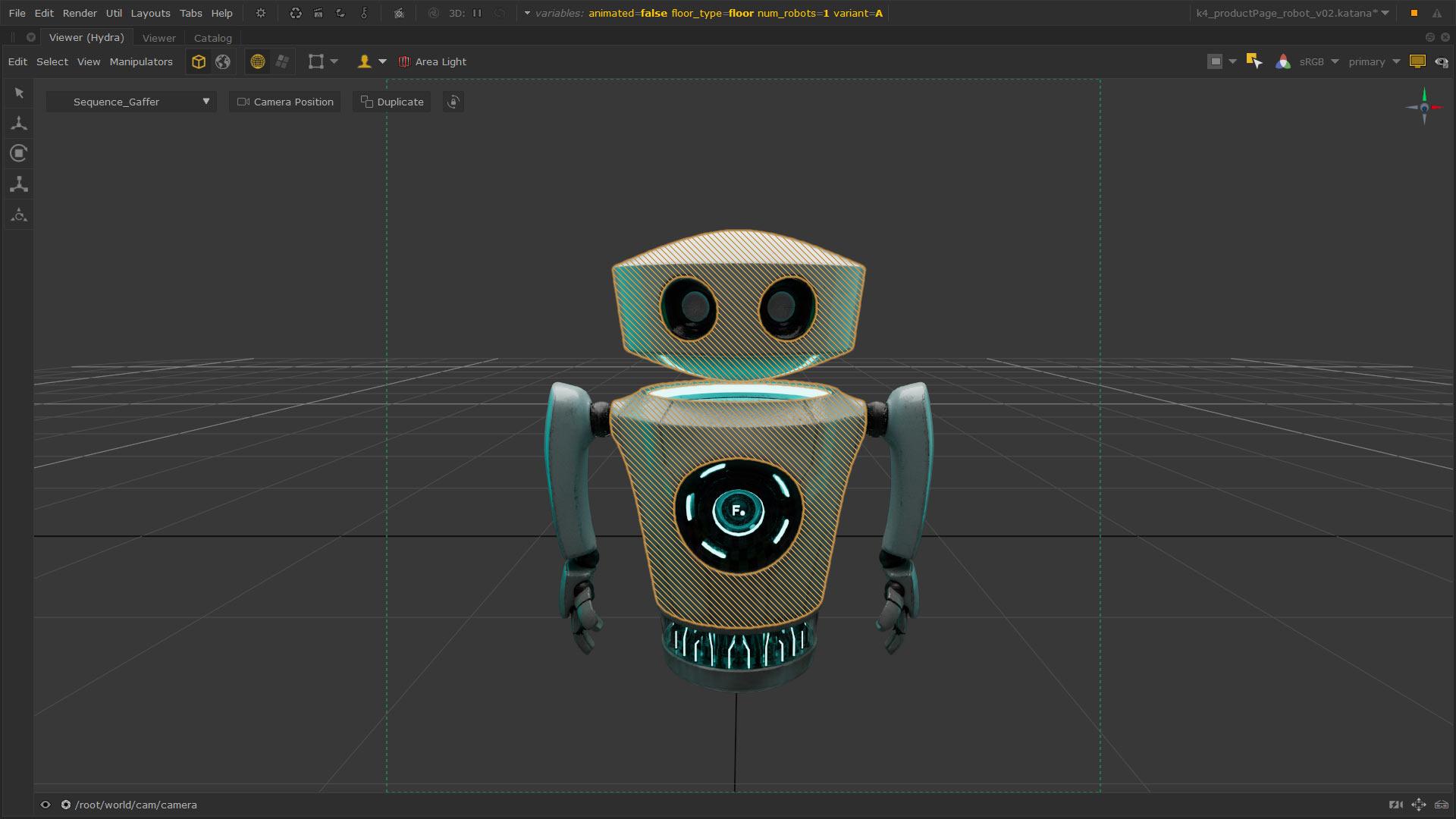
Katanaのパワーを引き出す
Katanaは、ルックデベロップメント/ライティングアーティストのクリエイティビティを最大限に引き出します。パフォーマンスタブのような新機能により、問題の調査に費やす時間を短縮し、より早く作業を進めることができます。
- Performance タブ - 新しいPerformanceタブを使って、シーンのデバッグをより効果的に行えます。このタブでは、ノードグラフ自体のサイズや、さまざまなノードに対して費やされた時間などを追跡することができます。Katana 6.0で導入されたこの機能により、カスタマイズ可能な色分けされたヒートマップを使って、ノードグラフのどのノードが最も多くの時間を消費しているかを確認し、どこにボトルネックがあるかを把握することができます。
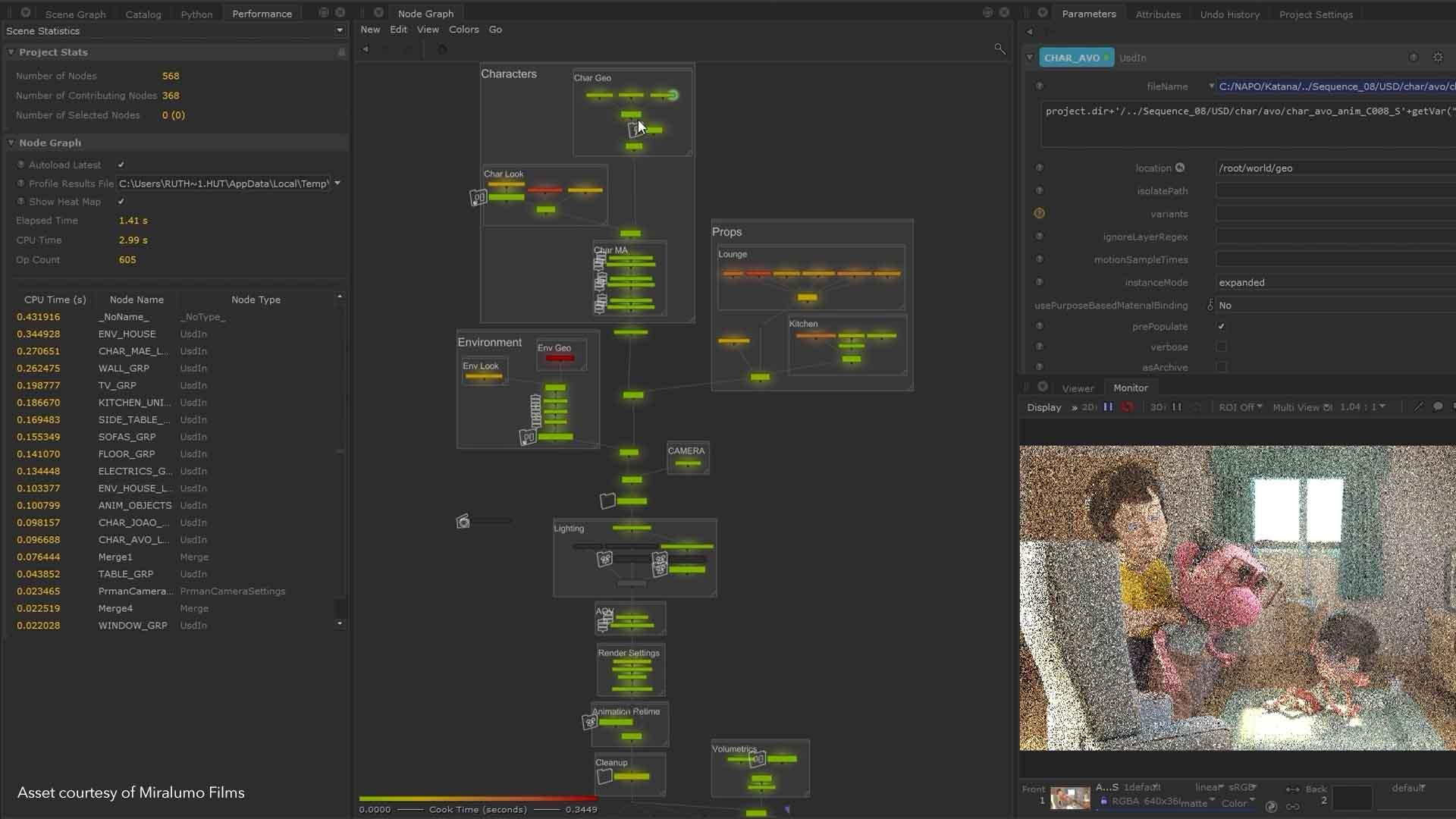
チーム
シームレスなコラボレーション
クリエイティビティは共有することで最大限に発揮されます。だからこそ、Katanaは、ルック開発/ライティングのチーム全体が連携し、効率的なワークフロー、機能、ノード、スクリプトを利用して、完璧な最終レンダリングを迅速に実現できるように設計されています。
- パワフルなノードグラフワークフロー - コラボレーションと再利用は、Katanaのルック開発とライティングの効率性の中核をなすものです。アーティストはノードグラフを使用して、作業の一連の手順を順序立てて定義し、それを他のチームメンバーと共有したり、プロジェクトの他の部分で再利用することができます。
- Live Group - Live Groupを使用すると、ノードグラフの一部をグループ化して公開し、それをディスクに保存して共有や再利用ができます。リファレンスシステムと同じように、グループの異なるバージョンを管理し、どこで使用されていてもその変更を反映させることができます。
- OpScript - OpScriptを使えば、テクニカルディレクターはシンプルな作業から複雑な一連のアクションまで、C++のコードを一行も書かずにカスタムツールを作成することができます。特定のツールをマクロとしてパッケージ化でき、技術的なスキルを持つ人がアーティストが使いやすいツールを作って、チーム全体の生産性を向上させることができます。
- マクロ - マクロを使用すると、複数のノードを簡単にパッケージ化して共有可能なツールを作成できます。スクリプトを使う必要がなく、どのコントロールを公開するかを選択できるため、不要な複雑さを減らし、ユーザーにとって明確でシンプルなインターフェースを提供します。
- SuperTool - SuperToolを使用すると、カスタムUIを備えた強力なツールを作成して動的にノードを生成し、シンプルなユーザー向けツールで複雑なワークフローを効率的に管理することができます。内部のノードはPythonスクリプトを使って生成および制御され、カスタマイズ可能なインターフェースを持つ単一の新しいノードとして提供されます。
- LiveShadingGroup - Katana 6.0 では、LiveShadingGroupの導入により、ルック開発ツールセットが拡張されました。Katana 4.5で導入されたマクロとユーザーパラメーター続くこの新機能により、プロジェクト、アセット、他のアーティスト間での作業の共有や再利用がさらにスムーズになります。元のLiveShadingGroupに加えられた変更は、自動的にそれを含むすべてのシーンに適用されるため、再度開いたときに手動で更新する必要がなくなります。作業の再利用とリサイクルによって、ワークフローを効率化しましょう。
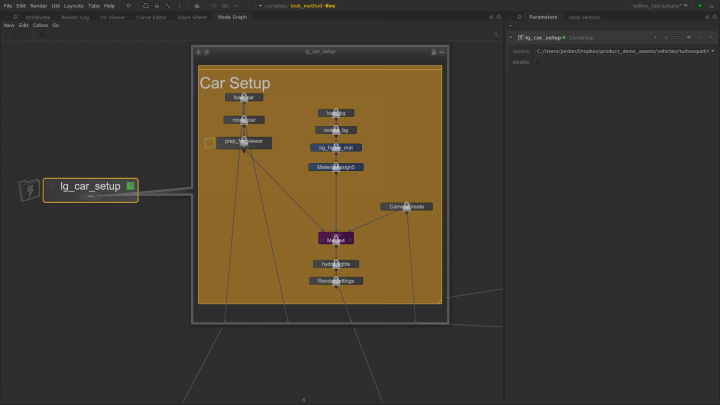
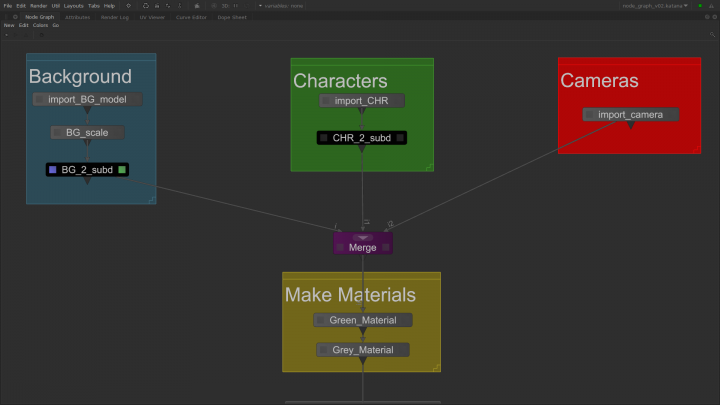
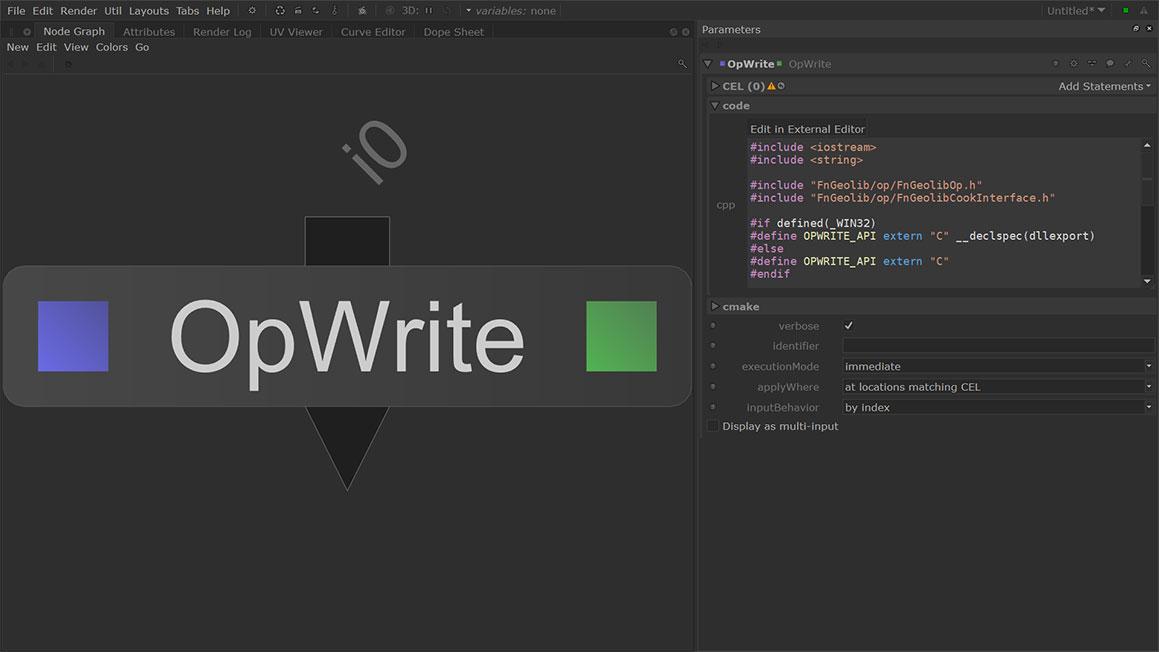
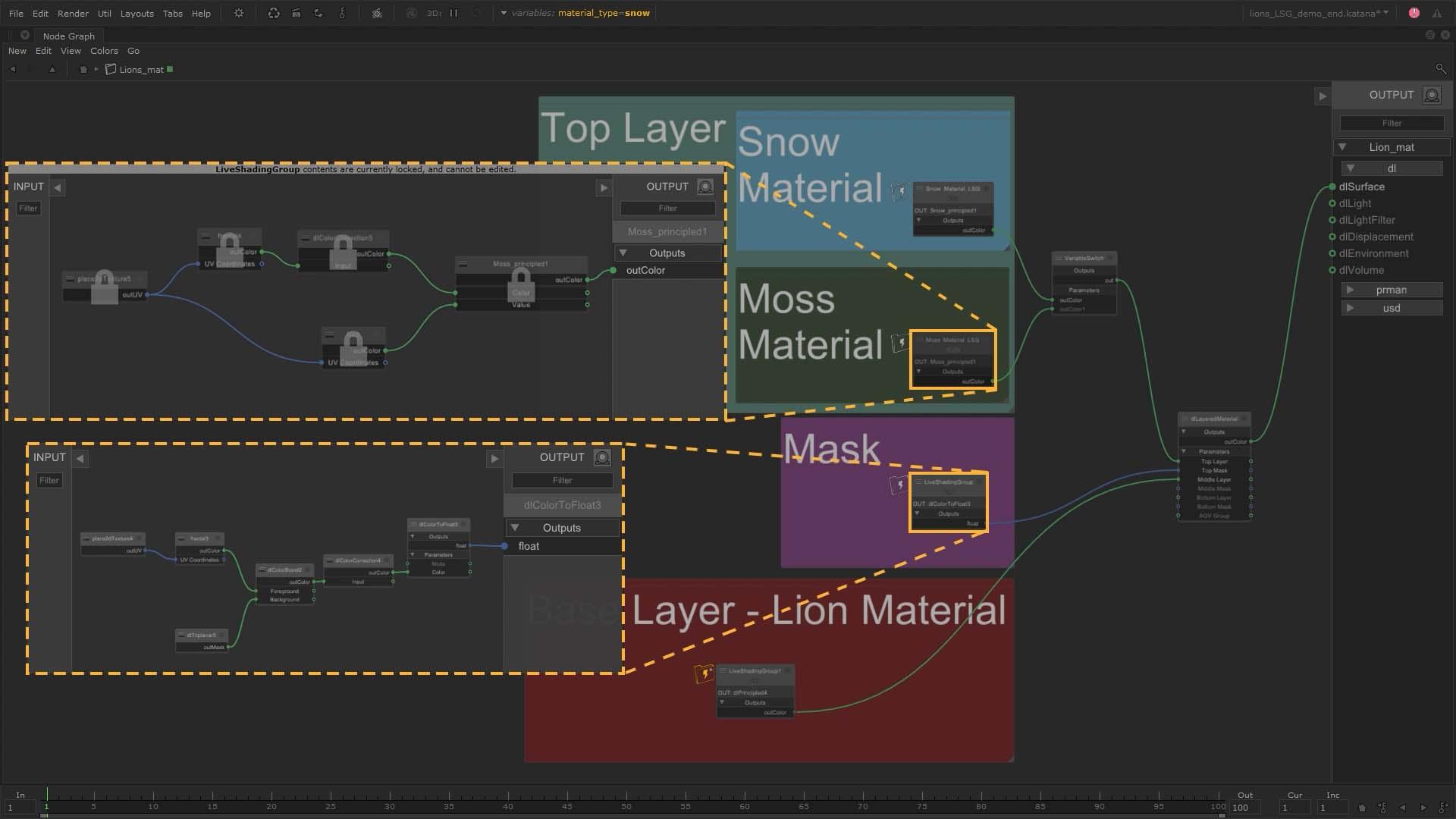
パイプライン
パイプラインを支える万能ツール
KatanaのDNAには、柔軟性、カスタマイズ性、そして相互運用性が組み込まれています。高度なUSDテクノロジー、広範なAPIとプラグイン、複数のスクリプト言語、そしてOCIOカラーマネジメントを備えたKatanaは、あらゆるニーズに対応し、パイプラインにおける不可欠なツールとして確固たる地位を築くことでしょう。
- USD シーン操作 - KatanaのUSDネイティブのワークフローで、パイプラインの摩擦を軽減。Nukeの新しい3Dシステムと同じ基本アーキテクチャ上に構築されたKatana 7.0は、複雑なシーン管理に強いKatanaと、USDネイティブのパイプライン柔軟性を組み合わせた、アーティストにとって便利で使いやすいワークフローの構築に焦点を当てています。シーン記述標準をツールに組み込むことを可能にした従来のUSD Katanaノードを拡張し、ネイティブUSD操作のフレームワークと新しいノード群を追加して、USDとKatanaの強みを融合し、そのパワーを最大限に引き出せるようにしました。
- OCIO カラーマネジメント - 業界標準のOpenColorIO (OCIO)カラーマネジメントが、Katanaのすべての画像関連の操作に適用されるため、色の正確さが保証され、安心して作業に集中できます。OCIOはKatanaと同様に、Sony Pictures Imageworksで開発されました。
- スクリプト言語とプログラミング言語の選択肢 - ILMのImathなどの強力なライブラリとともに、Python、Lua、C、C++ をサポートしており、あらゆるレベルのパイプライン開発者に優れた柔軟性を提供します。タスクに応じて適切な言語を選択し、迅速に作業を進めることができます。
- 豊富な API - Katanaには、アセット管理ツールへの接続、ロジックやカスタムUI、動的プロパティを備えた独自のカスタムツールの作成、独自のレンダーエンジンの追加、そしてKatanaとレンダーファーム間の複雑な接続の構築などが可能なAPIが含まれています。
- レンダラープラグイン - Katanaのレンダリングシステムは、V-Ray、Arnold、3Delight、RenderMan、Redshiftなど、既存のすべてのレンダラプラグインと100%互換性があります。すべてのプラグインは同じAPIを使用しており、カスタムレンダラープラグインを作成することもできます。3Delightプラグインはオープンソースで提供されており、制作時のリファレンスとして利用できます。

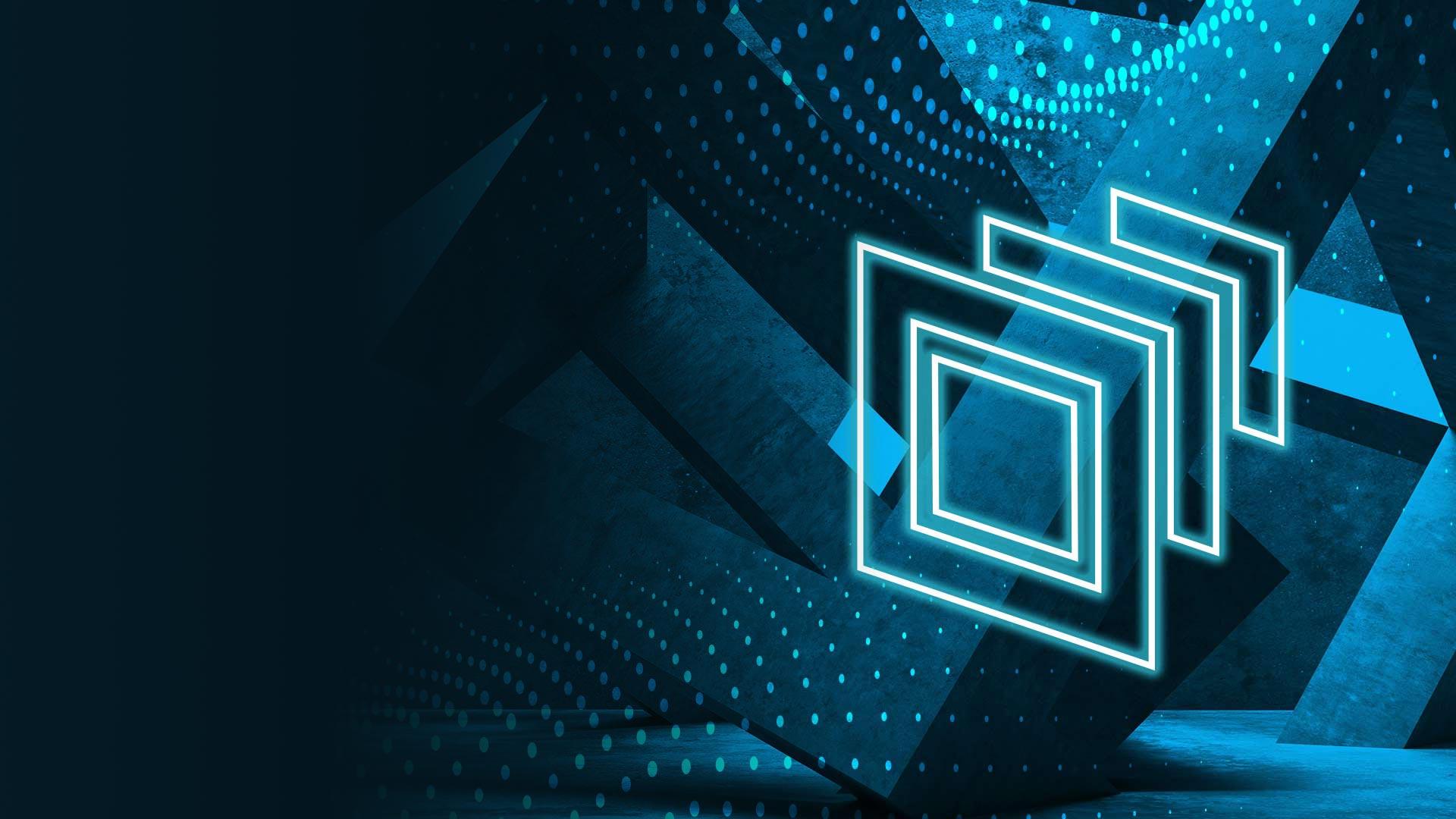
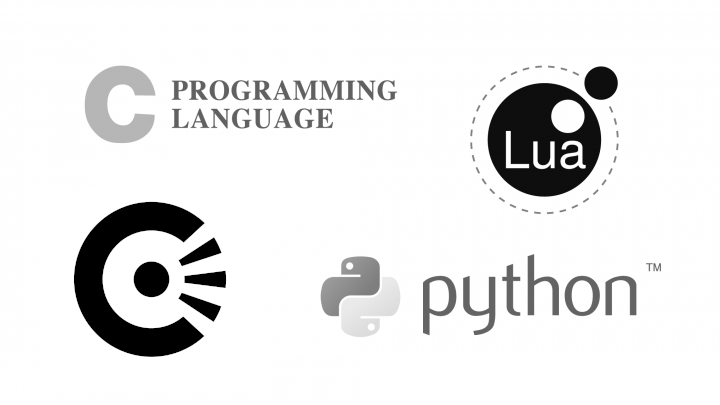
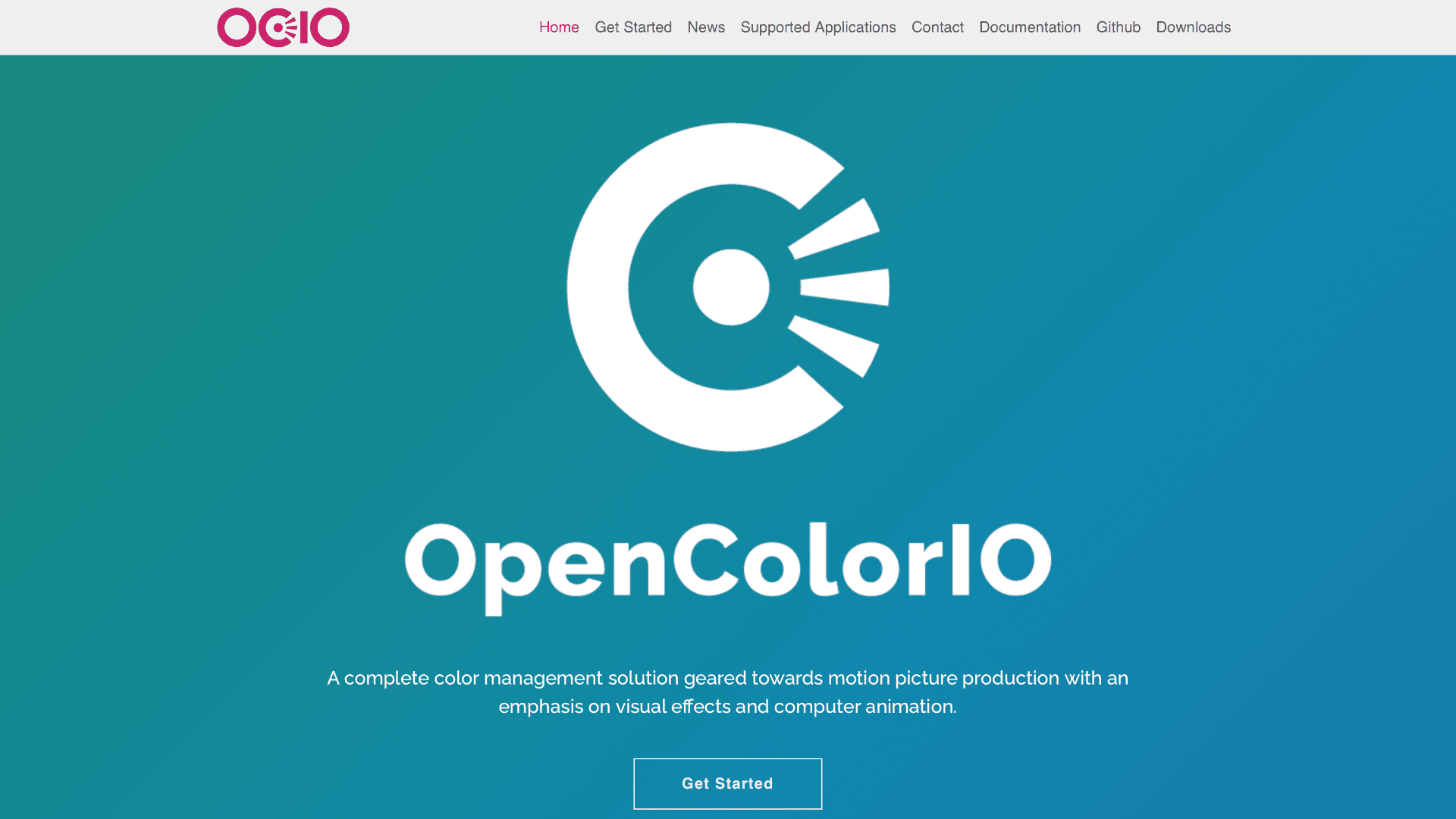
USD との完全なラウンドトリップ機能
Katana 8.0 では、USD との完全なラウンドトリップ機能が追加され、アプリケーション内で双方向にデータをやり取りできるようになりました。Katanaの信頼性の高いフレームワークと組み合わせることで、このラウンドトリップ機能は完全にサポートされ、USDへの移行がスムーズでリスクなく進められます。
- KatanaからUSDへのシームレスなデータ変換 - アーティストは新しいKatanaToUsdノードを使って、Katanaのデータを簡単にUSDデータに変換できるようになりました。これにより、Katana 7.0のUsdToKatanaノードと組み合わせることで、KatanaとUSD間でデータを双方向にやり取りでき、クリエイティブな作業がさらに効率化されます。また、アーティストはKatanaで使い慣れたツールをそのままUSDデータにも適用でき、USD用にツールを作り直す手間が省けるため、制作時間を大幅に短縮できます。
- USDエクスポート機能 - Katanaは、USDからのエクスポート機能が追加されたことで、USDパイプラインでの作業がシームレスに行えるようになりました。Katanaで行ったUSDの変更は、他の部署でも再利用できるようにエクスポートできるため、部署間のコラボレーションが促進され、アプリケーション間の互換性も向上します。ライトやマテリアル、カメラ、ジオメトリなど、あらゆるUSDの変更を簡単にエクスポートできるため、Katanaはパイプラインあらゆる部分で活用できます。
- パターンベースのコレクション機能 - Katana 8.0では、Katanaの強力なコレクション機能がUSD空間にも拡張され、さらに新しいパターンベースのコレクション機能が追加されました。このアップデートにより、アーティストのUSDワークフローが大幅に高速化され、日常的に使用するUSDネイティブノードの作業効率が向上します。従来、KatanaのワークフローでCELを活用してコレクションを使っていたアーティストは、新しいUsdCollectionノード(および他のノード内でのPBCサポート)を使用して、USD環境でも同様の作業ができるようになります。この機能によって、Katanaのテンプレートは複雑さに関わらず、あらゆるショットやシークエンスに柔軟に対応できるようになります。
- シーンエクスプローラーのコレクション機能 - 新しいコレクションパネルがメインシーンツリーの上に追加され、GeolibとUSDの両方でシーンエクスプローラータブ内にコレクションがサポートされるようになりました。このパネルは、新しいコレクションワーキングセットを使って操作でき、これによりシーン内の他のノードからコレクションを簡単に参照したり、アクセスしたりできるようになります。
- レンダラプラグイン - Katanaのレンダリングシステムは、V-Ray、Arnold、3Delight、RenderMan、Redshiftなどの主要なレンダラープラグインと完全に互換性があり、これらはすべて共通のAPIを使用しています。そのため、独自のカスタムレンダラープラグインも開発可能です。さらに、3Delightプラグインはオープンソースとして公開されており、実際の制作環境での活用例を参考にすることができます。
VFX Reference Platform 2024
Katana 8.0の機能は、最新のVFX Reference Platform 2024に対応しています。これにより、Katanaを他のFoundry製品やさまざまなツールと、これまで以上に簡単にパイプラインに統合できるようになりました。
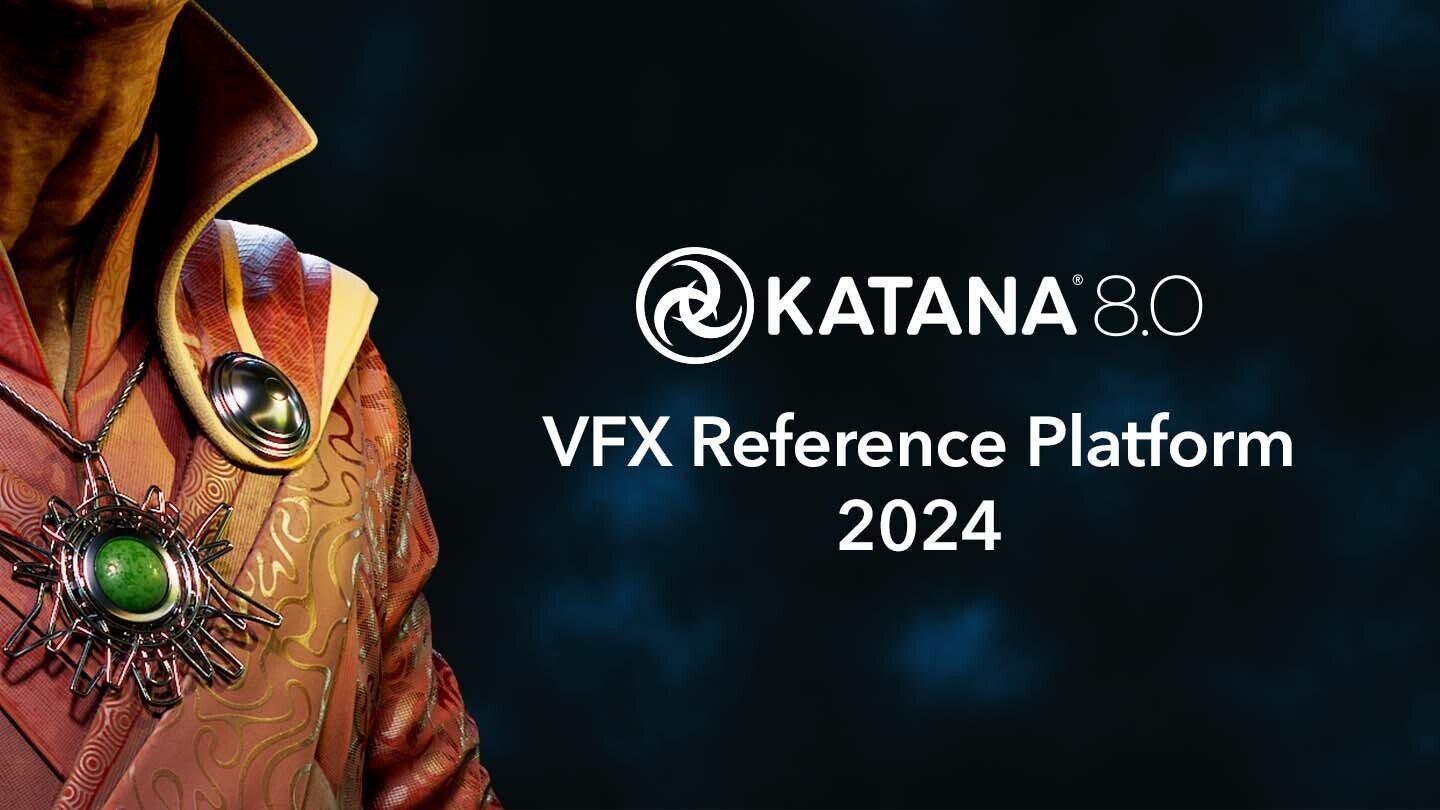
統合された3Delightレンダリング
Katanaには、3Delightのレンダリングプラグインが同梱されており、完全にインタラクティブなライブレンダリングが可能です。ライブレンダリングは、ライト、シェーダー、カメラ、ジオメトリ、ボリューム、マテリアル、グローバル設定など、シーンのあらゆる変更に対応し、アーティストに特化したエクスペリエンスを提供します。ライトミキシングなどのユニークなワークフローでは、完成したフレームのライティングをインタラクティブに調整でき、編集内容はKatanaのGafferThreeライティングツール内のライトやライトグループに直接フィードバックされます。さらに、OSLベースのシェーディングエンジンはKatanaとMayaの両方と互換性があり、DCCアプリ間でルック開発ファイルを直接転送できます。
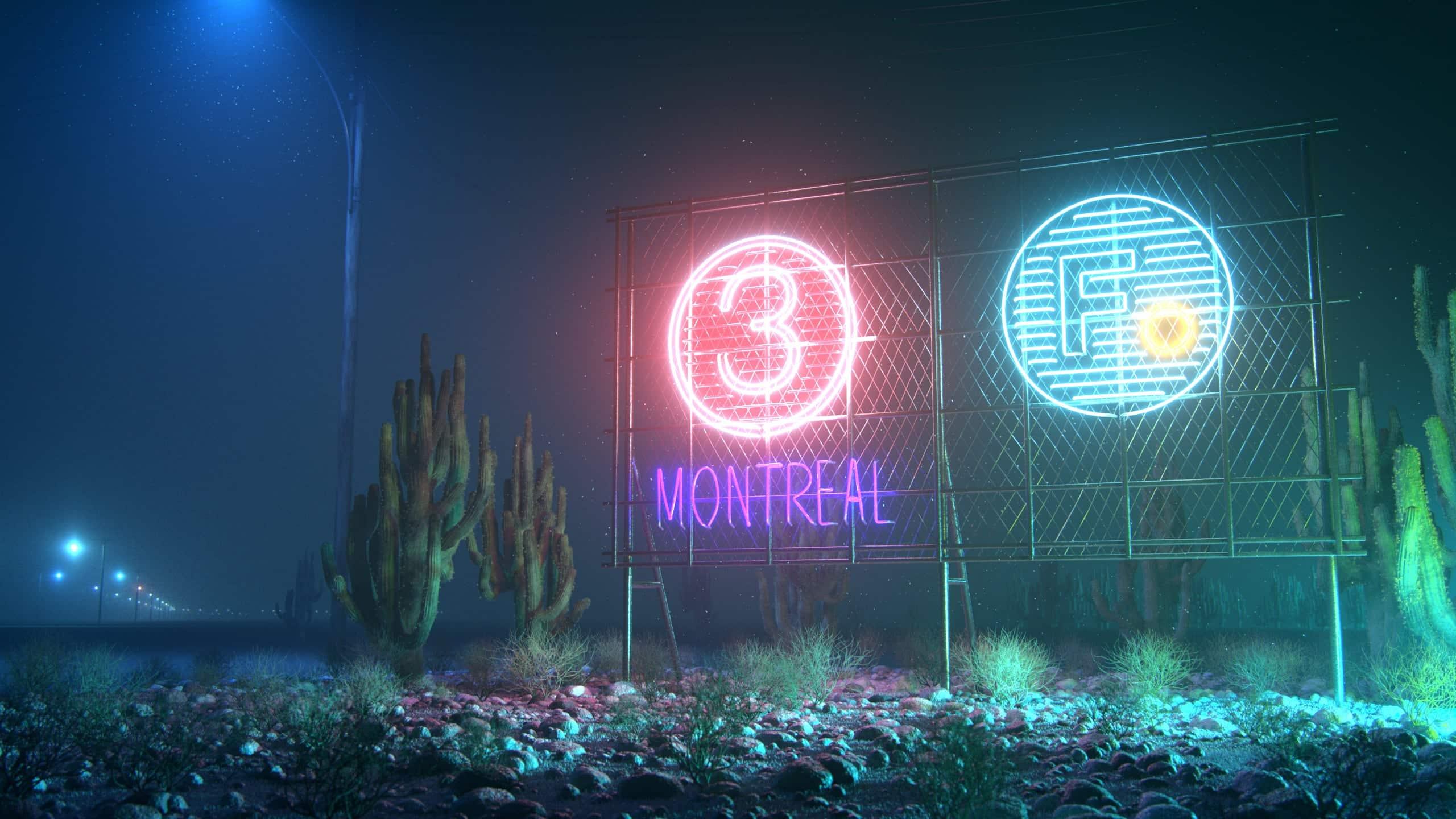
KatanaとNukeの連携
Katana 5.0では、ライティング/ルックデブアーティストが、Nukeのレンダリング環境で作業内容を確認できる新しいパイプラインの相互運用性が実現されました。Katanaからのレンダリングは、ローカルマシンやファーム上のフルコンポジット環境の一部として、実行中のNukeバージョンにライブストリーミングされます。NukeでのコンポジットをKatana内で直接確認できることで、アーティストは自信を持って作業を進めることができます。
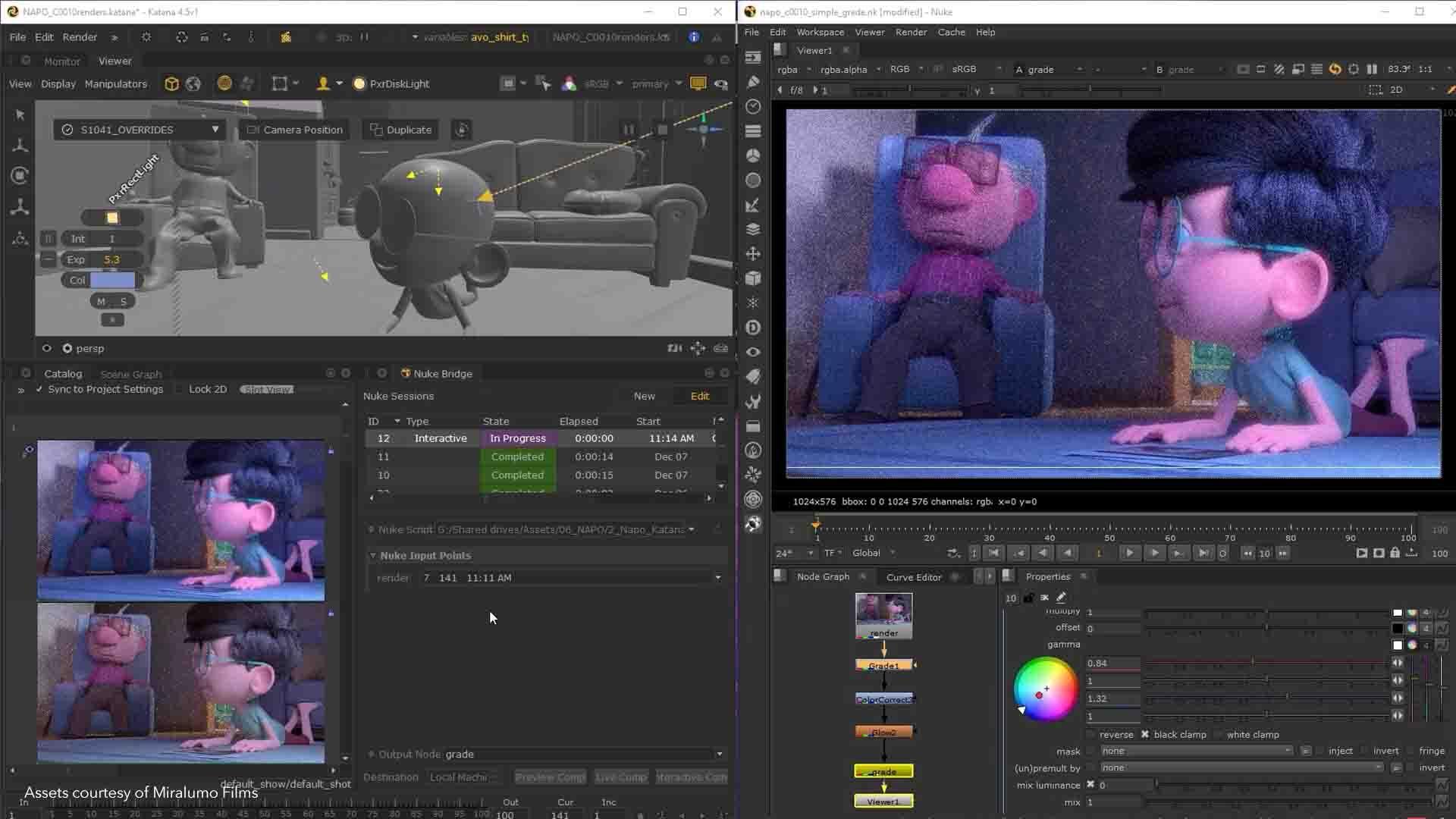
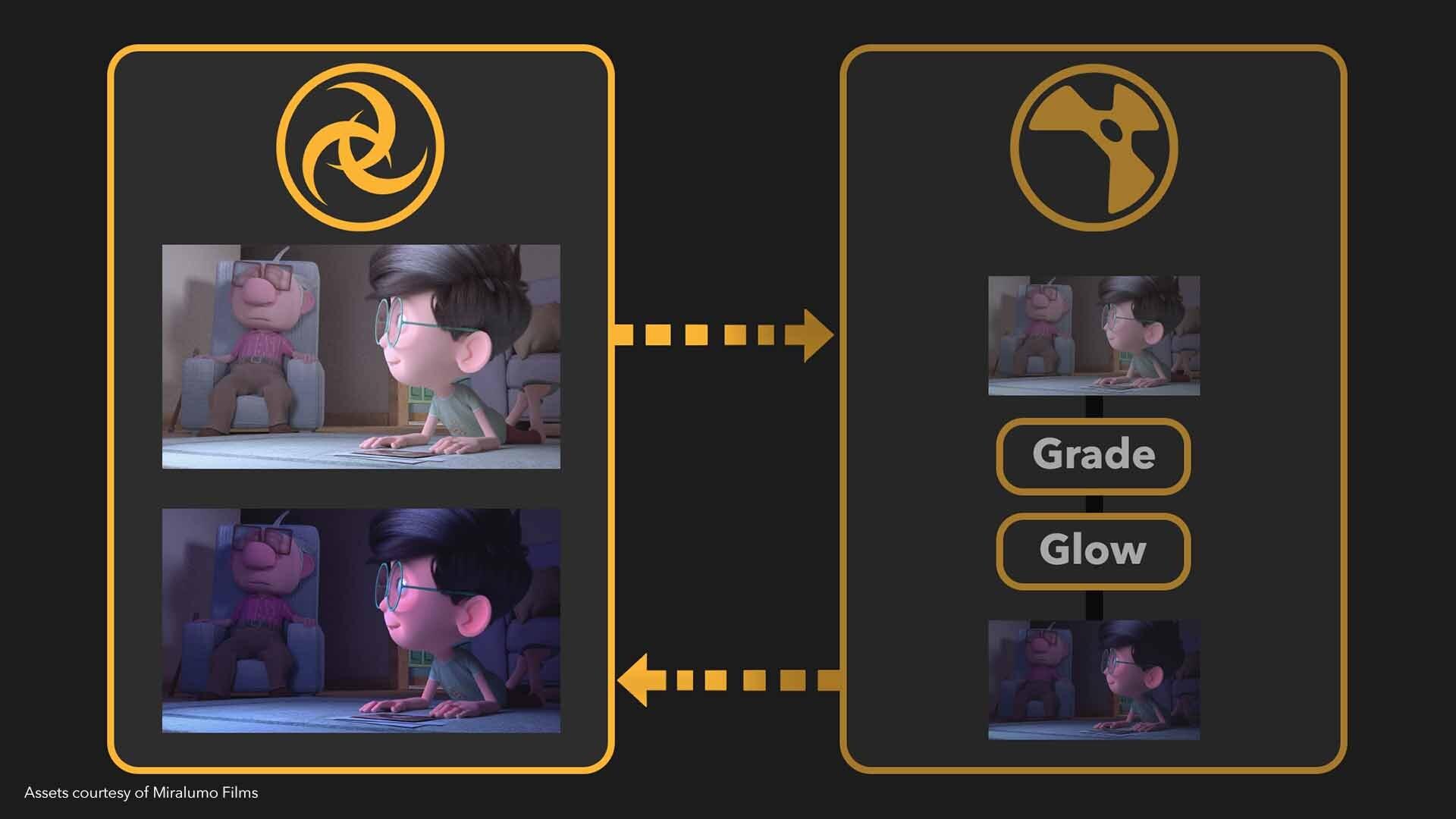

Geolib3-MTランタイムの最適化
Geolib3-MTランタイムが最適化されメモリ管理が改善し、ショットやシーン、シークエンスなど、重要な作業に集中できるようになりました。新しいキャッシュ戦略では、レンダリングがファームに適したスケーラブルで堅牢なソリューションが提供されます。
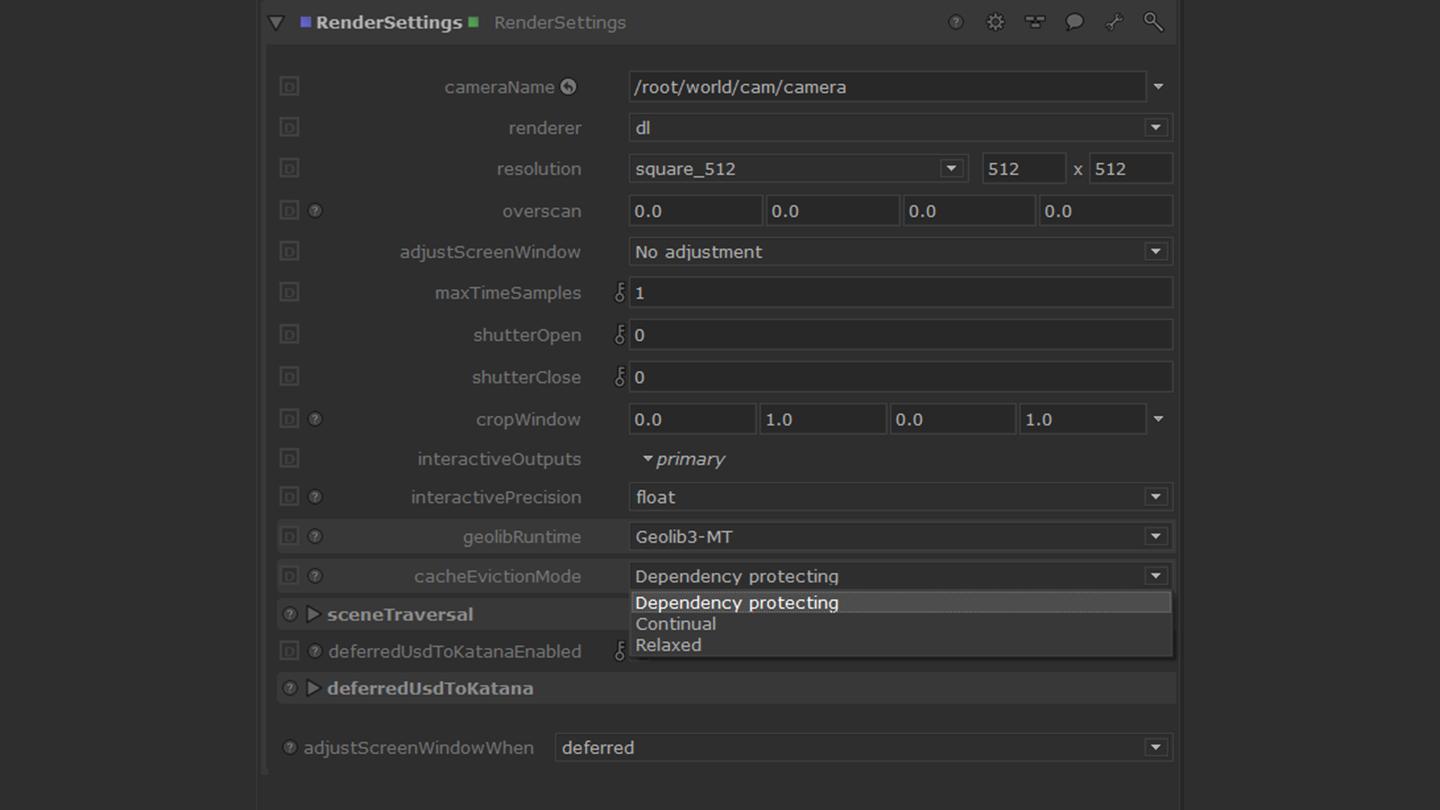
What's New
Foundryの製品リリースやその他最新情報をご確認ください。
Product releases
Insights
Katanaを体験する
Katanaが既存のパイプラインにどう適合するか、実際にご確認ください。
30日間無償トライアルで、Katanaのクリエイティブな機能を体験しましょう。
